How Much Does a Doctor Visit Cost With and Without Insurance?
Without insurance, medical care can get pricy fast. Where you live, what doctor you’re going to, and what tests you need will all figure into your doctor’s visit bill. In this article, we’ll break down those costs and give you some tips for saving money.

What Goes into the Cost of a Doctor’s Visit?
Geography is one of the biggest factors in the price of a doctor’s visit. Most medical facilities pass some of their overhead expenses onto their patients. If you live somewhere with a higher cost of living, like California or New York City, you’ll likely pay more for doctors’ visits. The practice has to pay more for utilities and rent, and those costs show up in your bill. For example, Mayo Clinic’s Patient Estimates tool quotes $846 for a 60-minute office visit in Jacksonville, Florida, but $605 for the same visit in Wisconsin.
Like the cost of living, supplies and equipment will also end up on your tab. Say you need a strep test, blood draw, or Pap smear. The supplies needed for the test plus the cost of the lab fees will all figure into the price.
Bills for the same exams and procedures can also vary depending on what kind of facility you’re going to. Smaller practices and public health centers are often a lot cheaper than university or private hospital systems. This is due in part to their buildings being smaller and their overhead fees being lower.
Price of Out-of-Pocket Doctors’ Visits
The cost of a doctor’s office visit also depends on what kind of doctor and the procedure you need to have done. For example, an in-office general wellness checkup will be cheaper than a specialist procedure. If you have an emergency, an urgent care center will be much more affordable than the emergency room.
Primary Care Physician — Physical Exam
Physicals usually include blood pressure readings, cholesterol measurements, and vaccines. Prostate exams for men and Pap smears and breast exams for women are also often included. Pediatric physicals focus on the growth milestones for your child’s age. Doctors check height, weight, sleep patterns, diet, and the vaccines required by public schools.
The range for a yearly physical can be anywhere from $100 to $250 or more without insurance. A CVS Minutecare Clinic may charge just $59 for a sports physical, but not all organizations will accept this as proof of physical health.
Primary Care Physician — Procedures
On top of the base cost for physical exams, you may have extra charges for any specific tests or procedures you need. According to the Cardiometabolic Health blog, the most common procedures in primary care medicine include bloodwork, electrocardiograms, and vaccines/injections.
Bloodwork is one of the biggest cost wild cards. Certain tests can run you from as little as $10 to as much as $10,000 . Large national labs like Labcorp offer pricing on their website, so you know what to expect going in. For example, Labcorp’s General Health Blood Test , which includes a metabolic panel, complete blood count (CBC), and urinalysis, costs $78.
Electrocardiograms or EKGs check your heart health and can find cardi ac issues. This quick procedure involves monitoring your heartbeat through electrodes placed on your skin. While it’s a painless and accurate way to detect heart conditions, the costs can add up without insurance. Expect to pay as little as $410 or as much as $1700 for this procedure, depending on local prices.
Vaccines are often required before sending your kids to school. The CDC publishes a vaccination price list annually to give you an idea of what to expect. For example, they quote $19-$132 for DTaP, $21 for Hepatitis A, and $13-$65 for Hepatitis B. The COVID-19 vaccine, however, is free of cost, regardless of insurance status.
Urgent Care Visit
If you have an emergency but are stable, urgent care is much cheaper than the emergency room. According to Scripps , most urgent care centers and walk-in clinics can at least treat dehydration, cuts or simple fractures, fever, flu, strep, and UTIs. Note that if you have chest pain, a serious injury, seizures, a stroke, or pregnancy complications, you should go straight to the ER .
For a base exam at an urgent care facility, expect to pay between $100-$150 . That price will go up depending on what else you need. For example, Advanced Urgent Care in Denver quotes $80 for an X-Ray, $50 for an EKG, $135 for stitches, and $5 for a urinalysis. In comparison, expect to pay $1,000-$1,300 for the same procedures in the emergency room.
How to Lower Your Out-of-Pocket Medical Costs

Healthcare expenses may seem overwhelming without insurance. Luckily, there are many resources available to help you cover the costs.
Free & Low-Cost Immunization and Wellness Clinics
For standard vaccines and checkups, look for local free or low-cost clinics. Check out The National Association of Free and Charitable Clinics’ search tool to find a location near you. Your city’s public health department should also offer free or low-cost vaccines and basic medical care services.
Certain large vaccine manufacturers also offer vaccine programs. For example, Merck’s patient assistance program offers 37 vaccines and medicines free to eligible patients. The program includes albuterol inhalers and vaccines for Hepatitis A, Hepatitis B, MMR, and HPV.
Cash Negotiations
Most health systems offer lower rates for patients paying cash. Some even have free programs for low-income families. For example, Heritage UPC in North Carolina has a yearly membership for low-cost preventative care. In Northern California, the Sutter Health medical system offers full coverage for patients earning 400% or less of the Federal Poverty Income Guideline .
As of January 1, 2021, all hospitals in the United States now have to follow the Hospital Price Transparency Rule . That means they have to list procedure prices clearly on their website. You can also call medical billing before your appointment to discuss cash pay options.
Federal Medical Payment Support
If all else fails, there are federal programs to help you cover the cost of medical bills.
Organizations like The United Way and United for Alice offer grants for ALICE (asset-limited, income-constrained, employed) patients. These are people living above the poverty level, making them ineligible for other government programs but below the basic cost-of-living threshold.
Medicaid is available for children, pregnant women, and adults under a certain income threshold. If your income is too high to qualify for Medicaid but you can’t afford private insurance for your children, you may be eligible for the Children’s Health Insurance Program (CHIP) to cover your children’s medical care.
Use Compare.com for the Best Doctors’ Visit Prices
Navigating bills for a doctor’s visit can feel overwhelming, but Compare.com is here to help. With our price comparison tool, you can search all clinic and doctors’ office prices in your area. Compare makes sure you’re prepared for the cost of your checkup long before you schedule your appointment.

Nick Versaw leads Compare.com's editorial department, where he and his team specialize in crafting helpful, easy-to-understand content about car insurance and other related topics. With nearly a decade of experience writing and editing insurance and personal finance articles, his work has helped readers discover substantial savings on necessary expenses, including insurance, transportation, health care, and more.
As an award-winning writer, Nick has seen his work published in countless renowned publications, such as the Washington Post, Los Angeles Times, and U.S. News & World Report. He graduated with Latin honors from Virginia Commonwealth University, where he earned his Bachelor's Degree in Digital Journalism.
Compare Car Insurance Quotes
Get free car insurance quotes, recent articles.

Cost of doctor visit by state
The following estimated costs are based on cash prices that providers have historically charged on average for doctor visit and will vary depending on where the service is done. The prices do not include the anesthesia, imaging, and other doctor visit fees that normally accompany doctor visit.
What happens at a doctor's visit?
People go to the doctor for routine physical exams as well as acute care when they get sick or injured. Visits to the doctor are important for preventing disease and managing any health problems. During your doctor’s visit, the physician checks your blood pressure, temperature, and heart rate.
Your doctor may listen to your heart, check your ears, nose, and mouth, and perform a physical exam. They may also ask you about your medical history and the medications you take. Your doctor may want you to have blood drawn for laboratory testing during your doctor’s visit.
How long should a doctor’s visit last?
It’s common for your entire visit to the doctor to take a long time. From start to finish, your appointment may take well over an hour . Many patients sit in the waiting room before being called back for examination.
How long you’ll wait depends on your specific doctor’s office and how busy they are. Once you’re in the exam room, the visit with your doctor will go quickly. On average, patients spend about 20 minutes in the exam room with their doctor.
Why are doctor visits so expensive?
Doctor's visits are expensive for several reasons, including their offices’ administrative responsibilities and the cost of medical services. Your doctor’s office has to work with different insurance companies and pay administrative staff trained in medical billing. Your doctor charges for their services, lab work, or imaging they run and may charge facility fees as well.
How much does a doctor visit cost without insurance?
Without insurance, your doctor’s visit can cost hundreds of dollars. On average, people in the U.S. pay just under $400 for their annual physical exam at a doctor’s office if they don’t have insurance. These costs include the provider fee for seeing the doctor and costs for any blood work or imaging that’s needed.
What are the signs of a bad doctor?
Know the warning signs of a bad doctor so you can avoid problems and get better medical care. One sign is if your doctor doesn’t listen to you or take your concerns into account during your visit. Another is if your doctor rushes through your appointment, not giving you the time needed to deal with your concerns.
A third warning sign is if your doctor doesn’t explain why certain tests or treatments are needed in a way you can understand.
What should you not tell your doctor?
Your doctor doesn’t need to know every detail about your life to provide proper care. But they do need you to be truthful about your health. You should never lie about the symptoms you’re experiencing or the medications you’re taking. If you aren’t taking medications as prescribed, your doctor needs to know. You don’t need to tell them health details they already know or give them any of your financial information.
Costs vary by specialty
The cost of a doctor visit could vary depending on the specialty. To see the cash prices for a specialist visit, type is a specialty.
* Savings estimate based on a study of more than 1 billion claims comparing self-pay (or cash pay) prices of a frequency-weighted market basket of procedures to insurer-negotiated rates for the same. Claims were collected between July 2017 and July 2019. R.Lawrence Van Horn, Arthur Laffer, Robert L.Metcalf. 2019. The Transformative Potential for Price Transparency in Healthcare: Benefits for Consumers and Providers. Health Management Policy and Innovation, Volume 4, Issue 3.
Sidecar Health offers and administers a variety of plans including ACA compliant and excepted benefit plans. Coverage and plan options may vary or may not be available in all states.
Your actual costs may be higher or lower than these cost estimates. Check with your provider and health plan details to confirm the costs that you may be charged for a service or procedure.You are responsible for costs that are not covered and for getting any pre-authorizations or referrals required by your health plan. Neither payments nor benefits are guaranteed. Provider data, including price data, provided in part by Turquoise Health.
The site is not a substitute for medical or healthcare advice and does not serve as a recommendation for a particular provider or type of medical or healthcare.

What common medical visits cost in Florida - and how they compare to nearby states
In the patchwork of health care providers in the United States, determining what a medical visit might cost can be confusing at best and life-altering at worst. The vast majority of patients who arrive at the hospital for a service recommended by their doctor do so without knowing the cost of that treatment. The price tag on most medical visits is so high for the uninsured, a full one-third of all money raised on GoFundMe is for health care costs.
A raft of legislation in nearly every state is set on tackling some of these endemic issues, with energy aimed squarely at lowering costs and expanding access. Some of this legislation is grand in scope, notably in states like New York where legislators are looking to put a public option on the table for residents there. Other states are taking a narrower approach, requiring providers to release price lists so patients are aware of what their care will cost.
Stacker analyzed cost data released on June 8, 2021, from the Centers for Medicare & Medicaid Services , common provider data from Verywell Health , and state zip codes from Simplemaps to find the average out-of-pocket cost for three typical medical visits in each state .
- Most common family practice visit costs --- Medicare recipients: $103.76 for established patients ($90.25 for new patients) --- Other insurance holders: $25.94 for established patients ($22.56 for new patients) - Most common internal medicine visit costs --- Medicare recipients: $103.76 for established patients ($135.26 for new patients) --- Other insurance holders: $25.94 for established patients ($33.82 for new patients) - Most common pediatric medicine visit costs --- Medicare recipients: $103.76 for established patients ($90.25 for new patients) --- Other insurance holders: $25.94 for established patients ($22.56 for new patients)
Florida is currently experiencing one of the worst COVID-19 outbreaks in the nation, and soon, patients in the state will have to start covering the cost of their own care. Many insurers have indicated that they will no longer cover COVID-19 care for their patients, including Blue Cross Blue Shield (Florida Blue), the state's largest provider.
Some trends held steady across most states. For family practice and pediatric visits, new patients often pay less than established patients. For internal medicine visits, new patients frequently pay more than established patients. Both of these trends exist regardless of insurance type.
Transparency is increasingly paramount in American health care. Keep reading for a look at what common medical visits cost in neighboring states and the state-level factors that may influence these costs.
- Most common family practice visit costs --- Medicare recipients: $99.34 for established patients ($85.95 for new patients) --- Other insurance holders: $24.83 for established patients ($21.49 for new patients) - Most common internal medicine visit costs --- Medicare recipients: $99.34 for established patients ($129.06 for new patients) --- Other insurance holders: $24.83 for established patients ($32.26 for new patients) - Most common pediatric medicine visit costs --- Medicare recipients: $99.34 for established patients ($85.95 for new patients) --- Other insurance holders: $24.83 for established patients ($21.49 for new patients)
One of Alabama's most serious medical issues sending patients to doctors and hospitals alike is prescription drug abuse. State legislature cracked down on so-called "doctor shopping" in 2021 with legislation that may decrease some of these case numbers. New legislation requires doctors to submit prescription information to a centralized database to prohibit abuse.
- Most common family practice visit costs --- Medicare recipients: $98.79 for established patients ($85.46 for new patients) --- Other insurance holders: $24.70 for established patients ($21.36 for new patients) - Most common internal medicine visit costs --- Medicare recipients: $98.79 for established patients ($128.38 for new patients) --- Other insurance holders: $24.70 for established patients ($32.09 for new patients) - Most common pediatric medicine visit costs --- Medicare recipients: $98.79 for established patients ($85.46 for new patients) --- Other insurance holders: $24.70 for established patients ($21.36 for new patients)
Georgia is one of a minority of states that have resisted Medicaid expansion. These states, largely in the Republican South, have broadly declined to expand Medicaid on ideological grounds. Much of the state, including its leading newspaper , is calling on the government to use funds from the American Rescue Plan to expand coverage for a half-million Georgian families who make about $17,900 a year.
Explore by Metro
Gainesville, homosassa springs, jacksonville, panama city, port st. lucie, punta gorda, tallahassee, the villages, west palm beach, trending now, 50 most meaningful jobs in america.

50 best crime TV shows of all time

Top 100 country songs of all time

100 best films of the 21st century, according to critics

Thanks for visiting! GoodRx is not available outside of the United States. If you are trying to access this site from the United States and believe you have received this message in error, please reach out to [email protected] and let us know.
An official website of the United States government
Here's how you know
Official websites use .gov A .gov website belongs to an official government organization in the United States.
Secure .gov websites use HTTPS A lock ( ) or https:// means you've safely connected to the .gov website. Share sensitive information only on official, secure websites.
How to pick a health insurance plan
Your total costs for health care: premium, deductible & out-of-pocket costs, think about a plan's deductible and copays, not just the premium.
The amount you pay for your health insurance every month. In addition to your premium, you usually have to pay other costs for your health care, including a deductible, copayments, and coinsurance. If you have a Marketplace health plan, you may be able to lower your costs with a premium tax credit.
Refer to glossary for more details.
Your expenses for medical care that aren't reimbursed by insurance. Out-of-pocket costs include deductibles, coinsurance, and copayments for covered services plus all costs for services that aren't covered.
- Monthly premium x 12 months: The amount you pay to your insurance company each month to have health insurance.
- Deductible : How much you have to spend for covered health services before your insurance company pays anything (except free preventive services)
- Copayments and coinsurance : Payments you make to your health care provider each time you get care, like $20 for a doctor visit or 30% of hospital charges.
- Out-of-pocket maximum : The most you have to spend for covered services in a year. After you reach this amount, the insurance company pays 100% for covered services.
Estimate the health and drug services you’ll use
Get estimated total yearly costs when you preview plans & prices.
- Enter some basic information (like ZIP code, household size, and income) when asked. Then, select View plans .
- Select Add yearly cost on any of the plans listed.
- Pick the level of care you expect to use this year— low, medium, or high use.
- Select Save and continue to get your Estimated total yearly costs for each plan listed.
Pick a health plan category that works for you
- If you don’t expect to use regular medical services and don’t take regular prescriptions: You may want a Bronze plan. These plans can have very low monthly premiums, but have high deductibles and pay less of your costs when you need care.
A discount that lowers the amount you have to pay for deductibles, copayments, and coinsurance. In the Health Insurance Marketplace®, cost-sharing reductions are often called “extra savings.” If you qualify, you must enroll in a plan in the Silver category to get the extra savings.
- If you expect a lot of doctor visits or need regular prescriptions: You may want a Gold plan or Platinum plan. These plans generally have higher monthly premiums but pay more of your costs when you need care.
Consider plans with easy pricing
- Doctor and specialist visits, including mental health
- Urgent care
- Physical, speech, and occupational therapy
- Generic and most preferred drugs
- Deductibles
- Out-of-pocket maximums
- Copayments/coinsurance
Compare only plans with easy pricing when you shop for coverage
- When viewing plans, select Add filters .
- Pick a Health plan category (Bronze, Silver, Gold, or Platinum). Then, select with easy pricing .
Health Spending
- Quality of Care
Access & Affordability
- Health & Wellbeing
- Price Transparency
- Affordability
- Prescription Drugs
How costly are common health services in the United States?
By Daniel McDermott , Julie Hudman , Dustin Cotliar, Gary Claxton , Cynthia Cox Twitter , and Matthew Rae Twitter
November 4, 2020
Stay Connected
Get the best of the Health System Tracker delivered to your inbox.
It is well documented that the U.S. is an outlier among peer countries when it comes to health spending, and recent Peterson-KFF analysis finds that the cost of inpatient and outpatient care is the primary driver behind this gap in health expenditures. In addition, countless news articles have highlighted extremely high medical bills sent to patients, often resulting from balance billing from out-of-network providers. However, the actual costs of specific healthcare services in the U.S. are often hard to track down and can vary widely between plans and across the country.
In this analysis, we explore the average cost of several common healthcare services in the U.S. We analyzed data from a sample of the IBM MarketScan Commercial Claims and Encounters Database, which includes health claims from non-elderly people enrolled in large employer plans. When possible, we show how these costs have changed over time and how they vary geographically.
The charts in this analysis show average allowed amounts large employer health plans agree to pay for in-network and out-of-network care. We refer to “cost” as the weighted average total expenditures made towards a given admission or service, including the portion paid by the health plan and any out-of-pocket costs paid by enrollees under the plan’s cost sharing. However, the charts do not include any balance bills (“surprise bills”) that out-of-network providers may send directly to patients.
This collection demonstrates that the costs associated with many common health services have risen more rapidly than general economic inflation, and that there are large geographic variations in the cost of the same health services across the United States. For example:
- The average cost of a hospital admission among large employer plans increased by roughly $10,000 (68%) from 2008 to 2018
- Over the same period, the average cost for a laparoscopic appendectomy increased nearly five times faster than inflation
- The average cost for a lower back MRI is nearly three times higher in the Houston, TX area ($1,106) than in the Las Vegas, NV area ($404)
Related Content:
Charges for emails with doctors and other healthcare providers
How financially vulnerable are people with medical debt?
There is wide variation in the cost of inpatient hospital admissions depending on the type of admission.
The average cost of an inpatient hospital admission for people with large employer coverage was $24,680 in 2018. The cost of a hospitalization varies widely, depending on the reason for the admission. Maternity and newborn admissions, for example, average $14,952, while the cost of a surgical admission is much higher, averaging $47,345. For the purposes of this analysis, the cost of an inpatient admission includes the cost of professional services provided by physicians or hospital staff as well as any drugs that may have been administered during the hospital stay.
The cost of inpatient hospital admissions for surgical and medical care nearly doubled from 2008 to 2018
Among people with large employer coverage, the average cost of inpatient hospital admissions has increased by nearly $10,000 (68%) since 2008. Inpatient admissions for surgical care experienced the steepest cost increases, rising by $22,291 (89%) over the decade. General medical admission costs also rose steeply, by $9,850, or 85%, over the decade. Psychiatric and substance use admissions also increased in cost by $6,139 (82%). For reference, inflation increased 17% over the same period.
The cost of an inpatient admission varied by location in 2008 and 2018
The cost of an inpatient admission has increased across all regions since 2008. The chart above shows the average cost of an inpatient admission across the 25 Metropolitan Statistical Areas (MSAs) with the highest number of inpatient admissions among large employer plans in 2018.
On average, inpatient hospital admissions were most expensive in the San Diego, CA, area in both 2008 and 2018. The least expensive areas for an inpatient stay also remained constant over that period – St. Louis, MO and the Louisville area in KY and IN.
The average cost of full knee or hip replacements varies considerably across markets
This figure shows the average cost of an inpatient admission for a full knee or hip replacement in most populous MSAs with more than 125 procedures in 2018. There is considerable geographic variation in the average cost paid by large employer plans and their enrollees for these surgeries. For instance, the average cost of a full knee or hip replacement in the New York City area is $56,739, which is 127% higher than the average cost in the Baltimore area ($25,044) and 61% higher than the national average ($35,263).
The average cost of a full knee or hip replacement has increased faster than other prices in the economy
The average cost of an inpatient admission for a full knee or hip replacement increased 38% (or $9,662) from 2008 to 2018, compared to a 17% increase in inflation over the same period (as measured by the GDP deflator).
The average cost of a laparoscopic appendectomy procedure has increased far faster than general inflation
Among large employer plans, the average cost of an inpatient admission for a laparoscopic appendectomy was $23,385 in 2018. The average cost for a laparoscopic appendectomy nearly doubled from 2008 to 2018 (increase of $11,456 or 96%), growing much faster than inflation over the same period (17%).
The average cost of laparoscopic gallbladder removal surgery has increased more than four times faster than general inflation.
A laparoscopic cholecystectomy involves the surgical removal of the gallbladder. The cost of an inpatient admission for this surgery nearly doubled from $15,900 in 2008 to $28,233 in 2018 – an increase of 78% over ten years, which was more than four times faster than inflation (17%).
The burden of medical debt in the United States
Health Cost and Affordability Policy Issues and Trends to Watch in 2024
The average cost of an inpatient admission that includes a heart attack costs more than twice as much in the new york city area than in the baltimore area.
There is considerable geographic variation in the average cost paid among large employer plans for an inpatient hospitalization that includes a heart attack. For instance, the average cost of a hospital stay that includes a heart attack in the New York area is $65,138, which is 37% higher than the national average ($47,666) and 137% higher than the average cost in the Baltimore area ($27,434).
The Baltimore area has lower-than-average costs for many inpatient admissions, including the lowest average cost for knee or hip replacements and inpatient admissions related to a heart attack. These lower inpatient prices may be due in part to Maryland’s all payer rate setting program .
Inpatient admissions for cardiac problems that require invasive surgical procedures can be much more expensive
Coronary artery disease— the buildup of plaque leading to reduced blood flow to the heart— forms the pathogenic basis for heart disease and heart attacks, the leading cause of death in the United States and a major driver of health spending.
Common treatments for these conditions aim to circumvent blockages in the arteries, and include cardiac catheterization and coronary artery bypass graft surgery (bypass surgery). Cardiac catheterization involves injecting a dye into the blood vessel to diagnose a blockage, and placement of a stent if appropriate. Bypass surgery involves grafting one or more blood vessels from other parts of the body with the coronary arteries to restore blood flow to the heart.
The average cost of an inpatient admission that included bypass surgery with catheterization (with or without a stent) and major complications was nearly $117,000 in 2018. An admission for a bypass surgery that did not involve catheterization or complications was $75,688 on average.
The average cost of an inpatient admission for an abdominal hysterectomy varies by surgical method
Hysterectomy costs vary based on the surgical method used and how much of the uterus and surrounding organs are removed. Most inpatient hysterectomies performed are ‘abdominal’ meaning the surgeon removes the uterus through a larger incision over the belly. This is in contrast to ‘laparoscopic’ and ‘vaginal’ approaches, which refer to performing the operation through smaller incisions in the abdomen or through the vagina, respectively.
Most inpatient hysterectomies are considered total hysterectomies, in which the surgeon removes the whole uterus and cervix. Other kinds include subtotal hysterectomies (removal of only a portion of the uterus leaving the cervix intact) and radical hysterectomies (removal of the whole uterus, the cervix, and the top part of the vagina). Any of these types of hysterectomies could also include the surgical removal of one or both of the fallopian tubes and/or ovaries.
Among large employer plans, the average cost of an inpatient admission for a total abdominal hysterectomy was $20,937 in 2018. Inpatient admissions for abdominal radical hysterectomies were substantially more costly at $36,485 on average, possibly because they are more invasive and because radical hysterectomies are often associated with malignancy and more complex conditions. The following chart shows costs for laparoscopic hysterectomies.
Total and subtotal hysterectomies performed laparoscopically on an outpatient basis are slightly less costly than inpatient abdominal hysterectomies
Laparoscopic hysterectomies are more common in outpatient settings and the cost of these procedures varies less dramatically than inpatient abdominal hysterectomies. On an outpatient basis, the average cost of a subtotal laparoscopic hysterectomy ($16,790) is just $343 less than the average cost of a total laparoscopic hysterectomy ($17,133). Laparoscopic hysterectomies are less invasive and, in most cases, require less recovery time than abdominal hysterectomies. Radical hysterectomies are also less commonly performed in outpatient settings.
There is considerable variation in the cost of outpatient visits depending on the severity and complexity of the visit
Outpatient physician visits with the highest level of acuity (the most severe and most complex) are coded as Level 5, whereas visits for straightforward, minor conditions are coded as Level 1. Physician visits for the most complex cases (Level 5) cost an average of $182 per visit, while compared to $46 for the simplest visits. The most common physician visits are coded as Level 3, which average $90 per visit. Overall, the average cost of an outpatient visit was $105 in 2018.
The following chart shows how the cost of an office visit has changed over time for each level.
Costs have increased over the past 10 years for all levels of outpatient visits
Average costs have increased for each of the five levels of office visits. From 2008 to 2018, the average cost of Level 1 office visits increased by $15 (or 52%) and the average cost of Level 5 office visits increased by $49 (or 37%). The average cost of Level 3 office visits, by far the most commonly coded severity, rose by $20 (or 29%) over the same period.
The average cost of outpatient visits varies considerably across markets
This chart shows the variation in the cost of Level 3 outpatient office visits across the largest MSAs with more than 10,000 visits in 2018. As an example, the average office visit in the Minneapolis and St. Paul area ($144) is more than double the average cost in the Louisville area ($68) and 60% higher than the national average ($90).
The average price of lower back MRIs has increased slower than inflation
Not all services have experienced rapid increases in prices. In 2018, the average price of an outpatient lower back MRI was $861, up from $784 in 2008. This represents a 9% price increase over 10 years, which was lower than general price inflation over the same period (17%). The prices here include the cost of the MRI itself and the professional cost of the radiologist interpretation.
The average price of lower back MRIs varies considerably by location
While the average price of a lower back MRI did not substantial increase from 2008 to 2018, there is large variation in the price of this procedure across the country. The highest average price for a lower back MRI is in the Houston, TX area ($1,106), which is nearly triple the average price in the Las Vegas area ($404), and 32% higher than the national average ($861).
The cost of outpatient surgery to repair torn knee cartilage varies considerably across the country.
Meniscus repair is an outpatient surgical procedure to repair torn knee cartilage. The national average cost for this procedure is $7,595, but there is considerable variation across MSAs. For example, the highest average cost for outpatient meniscus repair surgery is in the NYC area ($11,219), more than double the cost in the Detroit area ($4,655), and 48% higher than the national average.
There is considerable variation in the price of an allergy test across the country
The national average cost of an allergy test is $424, but there is a considerable range in prices across geographic areas. The highest average price for an allergy test is in the Cambridge, MA area ($575), which is 76% higher more than the average price in the Detroit area ($326).
Although recent policies have attempted to improve the transparency of health prices, a general lack of transparency makes it difficult for enrollees to know the total cost of a procedure or visit in advance, and even more difficult for them to know what their own liability may be. Additionally, many patients inadvertently receive treatment from out-of-network providers, putting them at risk for surprise medical bills . While this analysis examines average costs paid by insurers and enrollees for a number of common services, it also highlights the significant costs people may face for out-of-network providers.
The high cost of inpatient and outpatient care is the primary driver of the difference in health spending between the U.S. and similarly large and wealthy countries. As this analysis shows, even within the U.S., the cost of common health services can vary considerably from city to city (and a related analysis shows how these costs can even vary widely within cities). In some cases, this variation may be due to differences in severity of illness or complexity of service, but in other cases, this variation highlights extremely high and questionable prices set for care.
This analysis also shows that the cost of several health services has increased at a rate faster than general economic inflation – in some cases, many times faster. These rapidly rising costs of health services underlie growing premiums and deductibles for people with employer health insurance. Over the last decade, the amount employees have paid toward their premiums and out-of-pocket costs has exceeded wages , meaning that health care costs – and other expenses – have become harder to afford, even for those with relatively generous health coverage.
We analyzed a sample of claims obtained from the Truven Health Analytics MarketScan Commercial Claims and Encounters Database (MarketScan). The database has claims provided by large employers (those with more than 1,000 employees). This analysis only includes costs for services covered by large employer plans. We used a subset of claims from the years 2008 through 2018. In 2018, there were claims for almost 18 million people representing about 22% of the 82 million people in the large group market.
Weights were applied to match counts in the Current Population Survey for large group enrollees by sex, age, state and whether the enrollee was a policy holder or dependent. People 65 and over were excluded. We also limited claims to fee-for-service claims (excluding claims collected on an encounter basis). For all inpatient admissions, we excluded the top 0.5% of claims and claims that fall below either $5,000 or 10% of the average total price off the service, whichever is lower. For outpatient services or procedures, we also exclude the top 0.5% of claims and, unless otherwise specified below, claims that fall below either $5 or 10% of the average total price of the service, whichever is lower.
When showing the cost of a common service over time, we use the GDP deflator to benchmark the change in the price of the specific service against the change of prices in the general economy. The GDP deflator is a measure of inflation that captures the prices of all new, domestically produced goods and services. For charts depicting variation in the cost of a common service across Metropolitan Statistical Areas (MSAs), we select the 25 most populous MSAs with more than 125 procedures (unless otherwise specified in the text).
Midway through 2015, MarketScan claims transitioned from ICD-9 to ICD-10. While both systems classify procedures, they do not precisely crosswalk. Below is a summary of which codes we included:
- The cost of an inpatient admission for total knee or hip replacements are the cost of all services associated with an inpatient admission in which the principal procedure was ICD-9 code 81.54 or any of the subsequent procedures under the ICD-10 headings 0SRD and 0SRC. In addition, admissions without a principal procedure but in which the claim includes CPT code 27447 are included.
- The cost of an inpatient admission for a laparoscopic appendectomy is the cost of all services associated with an inpatient admission in which the principal procedure was ICD-9 code 47.01 or ICD-10 code 0DTJ4ZZ.
- The cost of an inpatient admission for a laparoscopic cholecystectomy is the cost of all services associated with an inpatient admission in which the principal procedure was ICD-9 codes 51.21- 51.24, or ICD-10 codes 0FB44ZZ, 0FT44ZZ, 0FT40ZZ, or 0FB40ZZ.
- The cost of an inpatient admission that include a heart attack is the cost of all services associated with an inpatient admission where the patient received one of the following ICD-10 codes: I2101, I2102, I2109, I2111, I2119, I2121, I2129, I213, I214, I220, I221, I222, I228 or I229.
- The cost of an inpatient admission for Coronary Artery Bypass Graft (CABG) surgery is the cost of all services associated with an inpatient admission where the associated diagnosis-related group (DRG) was 233, 235, or 236.
- The cost of an inpatient admission for an abdominal hysterectomy is the cost of all services associated with an inpatient admission where the admission includes CPT code 58150, 58152, 58180, or 58210.
- The cost of outpatient meniscus repair is the cost of all services on a day that contains the following: a diagnosis code under the ICD-10 headings S83.2 or M23 (meniscus injury), CPT code 29880 or 29881 (arthroscopy on knee), CPT code 01400 (anesthesia for knee surgery), and occurred in an ambulatory surgical center or in a hospital on an outpatient basis.
- The cost of an outpatient laparoscopic hysterectomy is the cost of all services on a day in which the primary procedure was CPT code 58570-58575 (total) or 58541-58544 (subtotal).
- The cost of outpatient lower lumbar MRIs includes the cost of outpatient claims with a CPT code of 72148. In addition to claims for professional services, some claims include facility fees. In cases in which no other professional services are provided on the date of service, facility fees were included in the cost of the MRI. In order to ensure that we are capturing the cost of performing the MRI and not associated services, claims in which all the cost in a day have a procedure modifier 26 are excluded.
- The cost of an outpatient office visit is the weighted average of the cost of CPT codes 99211, 99212, 99213, 99214 and 99215. These visit codes are for established patients but vary in complexity and duration. Claims with a total cost less than $5 were excluded.
- The cost of an allergy test is the weighted average cost of CPT codes corresponding with common skin tests: 95024, 95004, 95018, 95027, 95017, 95028, and 83520. Claims with a total cost less than $5 were excluded.
About this site
The Peterson Center on Healthcare and KFF are partnering to monitor how well the U.S. healthcare system is performing in terms of quality and cost.
More from Health System Tracker
How do health expenditures vary across the population?
Looking for more data?
Find out more details about U.S. healthcare from our updated dashboard.
A Partnership Of
Share health system tracker.
How much does Doctor On Demand cost?

Doctor On Demand is a covered benefit for over 98 million Americans, which means your visit will cost $0. If not a covered benefit, prices start at $89.
Here's how to find out:
- Download the app
- Register and create your account
- Add your insurance information
- Your cost will show before your visit
We partner with leading health plans and employers to serve millions of members around the country. Your telehealth visit may be as low as $0 /visit.
With Insurance
Without insurance.
See if we take your plan in just a few seconds:
Great news! Doctor On Demand works with INSURANCE_PROVIDER! Please create your account to find available doctors.
We also partner with hundreds of leading employers to offer $0 virtual care services, or you can take a visit at the prices listed below. Create a free account to learn more.
Board Certified Clinician
- $89 for a 15 min consultation
Psychologist
- $134* for a 25 min consultation
- $184* for a 50 min consultation
Psychiatrist
- $299 for initial 45 min consultation
- $129 for 15 min follow-up
Your estimated cost might change as we learn more details about your coverage, such as your specific benefits, or whether you’ve met your deductible. Register or log in to see your actual cost. We will always share the cost of your visit before you book your appointment.

We partner with these leading health plans and many more to serve millions of members around the country. This means your visit may be completely covered at no cost to you. To find out, register for Doctor On Demand and enter your plan information.
Register in the app and be ready to see a doctor, therapist or psychiatrist anytime, anywhere. Available for iPhone and Android.
What we treat
Urgent care.
- Cold and flu
- Sinus infections
- Skin rashes
- Asthma and allergies
- Urinary tract infections
- Headaches and migraines
- See all Urgent Care
Behavioral Health
- Anxiety and depression
- Trauma and loss
- Bipolar disorder
- Relationship issues
- Mental health screenings
- See all Behavioral Health
Virtual Primary Care
- Wellness visits
- Lab and screenings
- Chronic conditions
- Diet and nutrition
- RX management
- Specialist referrals
- Family medicine
- Men’s and women’s health
Chat-based Coaching
- Healthy habits
- Trouble sleeping
- Work stress
- Motivation to change
- Skip to primary navigation
- Skip to main content
- Skip to primary sidebar
- Skip to footer

- Best Global Medical Insurance Companies
- Student Insurance
- Overseas Health Insurance
- Insurance for American Expats Abroad
- Canadian Expats – Insurance and Overseas Health
- Health Insurance for UK Citizens Living Abroad
- Expat Insurance for Japanese Abroad
- Expat Insurance for Germans Living Abroad
- Travel Medical Insurance Plans
- Trip Cancellation Insurance
- Annual Travel Insurance
- Visitors Insurance
- Top 10 Travel Insurance Companies
- Best Travel Insurance for Seniors
- Evacuation Insurance Plans
- International Life Insurance for US Citizens Living Abroad
- The Importance of a Life Insurance Review for Expats
- Corporate and Employee Groups
- Group Global Medical Insurance
- Group Travel Insurance
- Group Life Insurance
- Foreign General Liability for Organizations
- Missionary Groups
- School & Student Groups
- Volunteer Programs and Non-Profits
- Bupa Global Health Insurance
- Cigna Close Care
- Cigna Global Health Insurance
- Cigna Healthguard
- Xplorer Health Insurance Plan
- Navigator Health Insurance Plan
- Voyager Travel Medical Plan
- Trekker Annual Multi-Trip Travel Insurance
- Global Medical Insurance Plan
- Patriot Travel Insurance
- Global Prima Medical Insurance
- Student Health Advantage
- Patriot Exchange – Insurance for Students
- SimpleCare Health Plan
- WorldCare Health Plan
- Seven Corners Travel Insurance
- Trawick Safe Travels USA
- SafeTreker Travel Insurance Plan
- Unisure International Insurance
- William Russell Life Insurance
- William Russell Health Insurance
- Atlas Travel Insurance
- StudentSecure Insurance
- Compare Global Health Insurance Plans
- Compare Travel Insurance Plans
- Health Insurance in the USA
- Health Insurance in Mexico
- Health Insurance in Canada
- Health Insurance in Argentina
- Health Insurance in Colombia for Foreigners
- Health Insurance in Chile
- UK Health Insurance Plans for Foreigners
- Health Insurance in Germany
- French Health Insurance
- Italian Health Insurance
- Health Insurance in Sweden for Foreigners
- Portuguese Health Insurance
- Health Insurance in Spain for Foreigners
- Health Insurance in China
- Health Insurance in Japan
- Health Insurance in Dubai
- Health Insurance in India
- Thailand Health Insurance
- Malaysian Health Insurance for Foreigners
- Health Insurance in Singapore for Foreigners
- Australian Health Insurance for Foreigners
- Health Insurance in New Zealand
- South Africa Health Insurance for Foreigners
- USA Travel Insurance
- Australia Travel Insurance
- Mexico Travel Insurance
- News, Global Health Advice, and Travel Tips
- Insurance Articles
- Travel Advice and Tips
- Best Hospitals in the United States
- Best International Hospitals in the UK
- Best Hospitals in Mexico
Or call for a quote: 877-758-4881 +44 (20) 35450909
International Citizens Insurance
Medical, Life and Travel Plans!
U.S. 877-758-4881 - Intl. +44 (20) 35450909
How Much Does Healthcare Cost in the USA?
What you need to know about healthcare costs in the united states.
People often warn visitors to America to purchase a health insurance plan before their trip because of horror stories about healthcare costs in the USA. They talk about outrageous bills for the uninsured party who finds themselves in trouble. But these dramatic stories don't really reflect the cost of healthcare in the United States - or do they? Here’s what you need to know about the cost of healthcare in the U.S. to make the best choices for your trip.
Despite its mixed reputation, healthcare in the United States performs exceptionally well in many regards. For instance, it has the best outcomes in the world for surviving a heart attack or stroke. However, it does not do well when it comes to chronic conditions like diabetes and asthma.
Waiting times, a concern in many countries with advanced health care systems, are less of a problem in the United States. Preventative health care spending is only slightly lower than in other industrialized nations. Overall, the standard of healthcare in the United States is very high. But so is the average cost of healthcare in the U.S.
US Health Insurance Plans Coverage and Costs of Insurance in the USA
If you reside in the US and your parents are planning a visit, consider one of the three travel insurance plans for parents visiting the USA .
What Is the Cost of Healthcare in the US Without Medical Insurance?
Below are average American healthcare prices for common procedures and services. These are estimates. The actual costs will vary depending on the healthcare facility providing the services. The infographics below will give you a good overview of the costs you may incur when visiting a doctor or hospital without insurance. These are the prices a visitor to the USA may face if they do not have a travel insurance plan or international health insurance plan .
These infographics list some of the typical, routine or unforeseen medical services that people require, along with their average costs. Much of this data comes directly from U.S. hospitals, which are required to list the cost of 300 of the most common medical procedures. As you will see, the cost of a doctor's visit or the average cost of a hospital stay in the U.S. varies widely depending on the services you need.
What Is the Cost of an Emergency Room Visit?
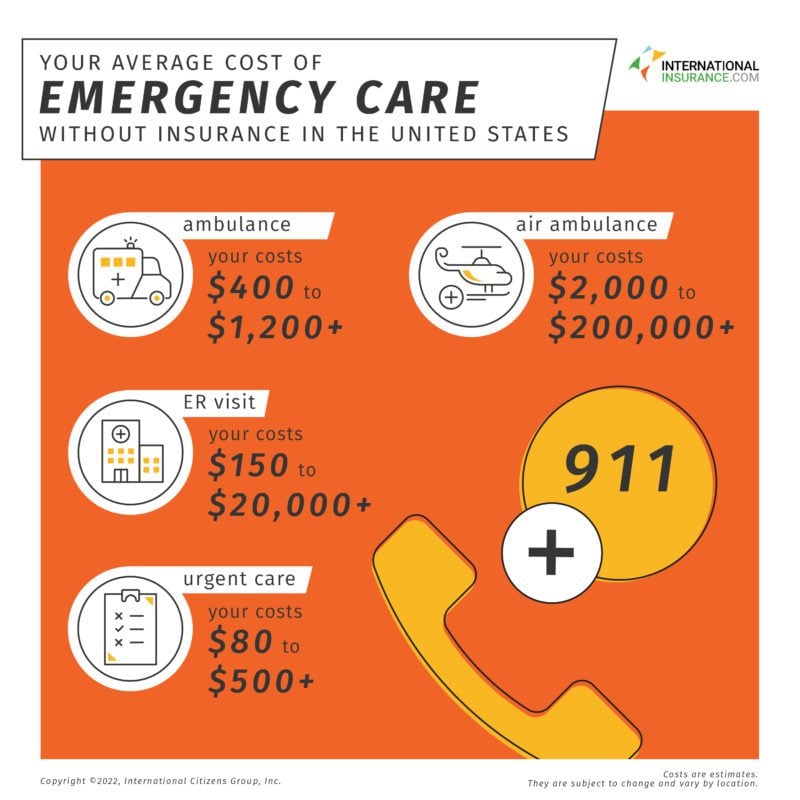
If you become ill and in need of emergency care, American healthcare prices will start adding up right away. An ambulance to take you to the hospital will start at $400. If you need tests, typical additional costs are $100 - $500. Should you need to spend the night, an additional charge of $5,000 might be added to your bill. With medications to treat your illness, the total cost of an emergency room or ER visit could be $6,000 or more!
What Is the Cost of Cancer Treatment Without Insurance?
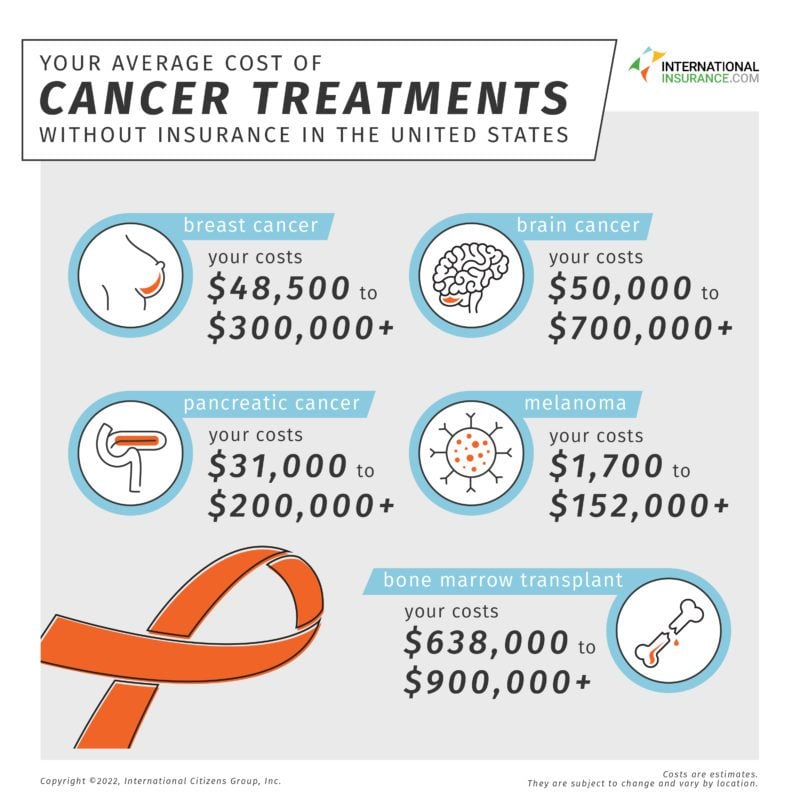
Having cancer is enough to make anyone feel anxious about the uncertain road ahead. So any unwelcome medical costs will only add to those stress levels if you are uninsured. And, unfortunately, the costs for treatments in the U.S. \come with a high price tag. Nearly breaking the million-dollar mark is a bone marrow transplant. It could cost more than an eye-watering $900,000+. Prices start at a still pretty extortionate $638,000.
Brain cancer treatment costs anything from $50,000 to a lofty $700,000+, while breast cancer costs range from $48,500 through to $300,000+. The price it takes to tackle pancreatic cancer starts from $31,000 through to $200,000+. And melanoma treatment can be anywhere from $1,700 to $152,000+.
What Are the Costs of Common Lab Tests Without Insurance?
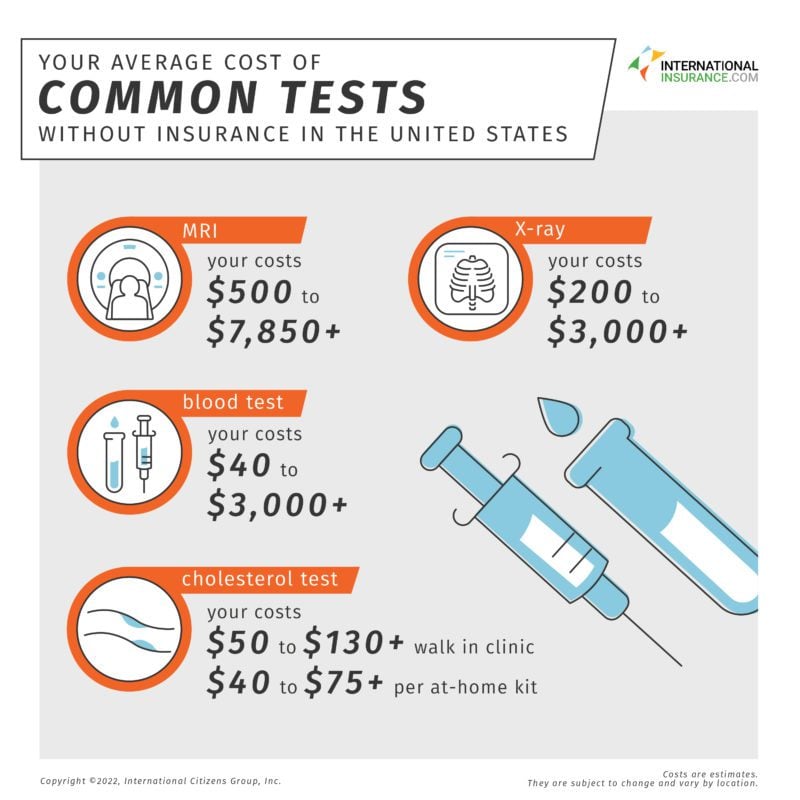
If a doctor is trying to diagnose your medical problem, common lab tests are important. But this is another area where the cost of healthcare in the US is high. An MRI scan will cost from $500 and up to, if not beyond, a costly $7,850+. A blood test, one of the most frequent lab tests, could be a seemingly low $40 but can ramp up to a staggering $3,000+. A cholesterol test at a walk-in clinic can be $50 to $130+ and $40 to $75+ for an at-home kit. An X-ray can cost between $200 but might also creep up to $3,000+ or more, depending on the circumstances.
What Could Prescription Drugs Cost?
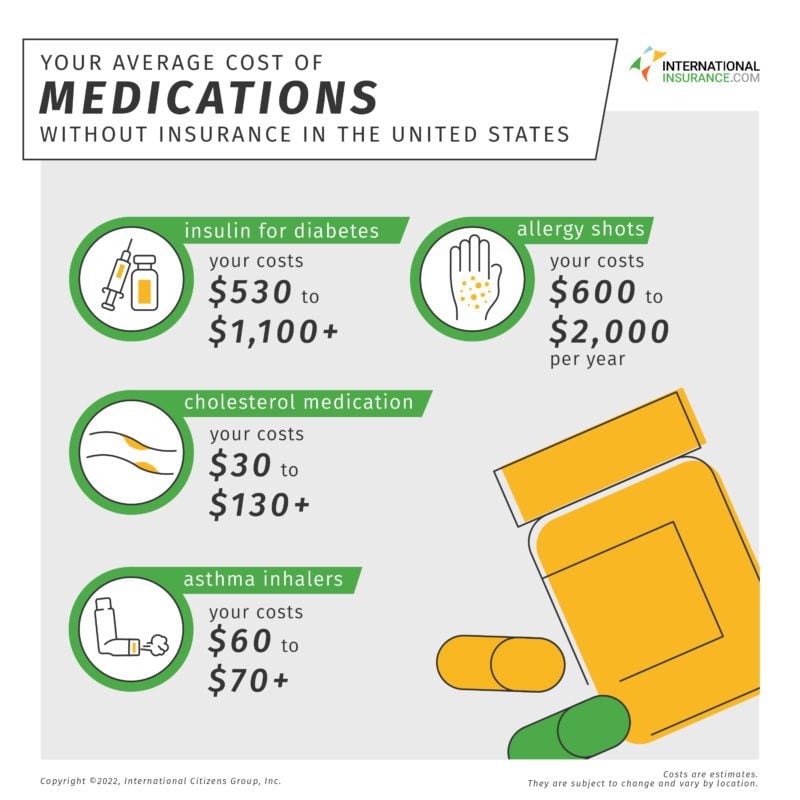
American healthcare prices are also high when it comes to prescription medication. If you have diabetes and need insulin, you could be facing a cost of $530 to more than $1,100+. A year’s worth of allergy shots will set you back $600 to $2,000+. If you require cholesterol medication, you could see a $30 to $130 bill. Asthma inhalers cost between $60 and $70+. Prescription drugs can become a big part of a patient's budget.
What Is the Cost of Family Planning Without Insurance?
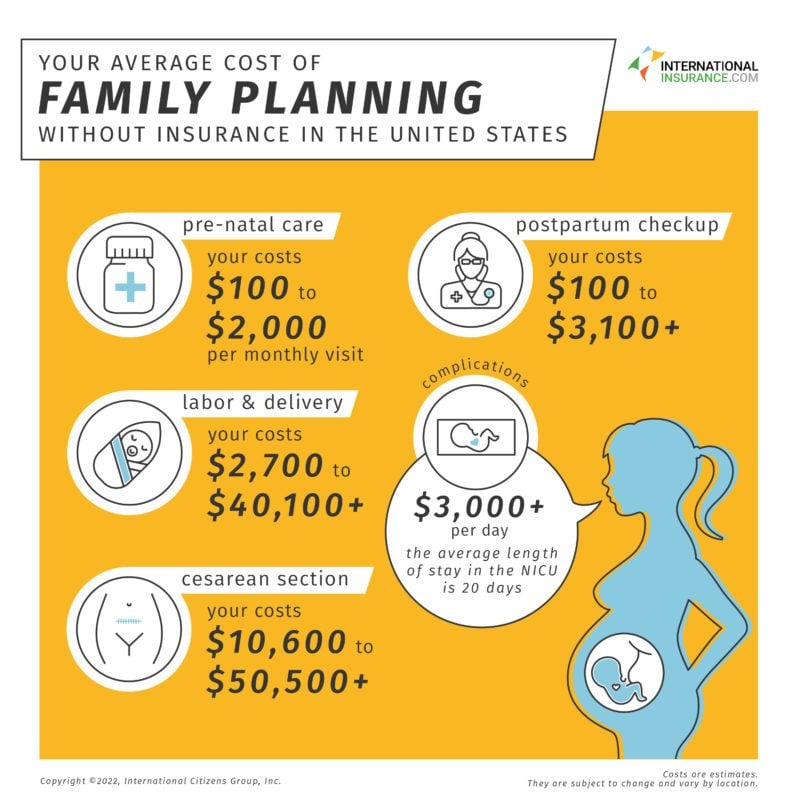
If you require pre-natal care, the average cost of a doctor's visit is between $100 and $2,000+. This adds up to a big total throughout even a single pregnancy. Should you go into labor and need assistance delivering your baby, this will cost anything from $2,700 up to and over $40,100.
Surgery in the form of a cesarean section costs between $10,600 and $50,500+. A postpartum check-up costs between $100 and $3,100+. If you have any birth complications, this tends to cost $3,000+ per day. And the average length of stay in the NICU is 20 days, meaning that you could potentially face a $60,000+ bill at the end of all your troubles.

What Does It Cost to Have Surgery Without Insurance in the USA?
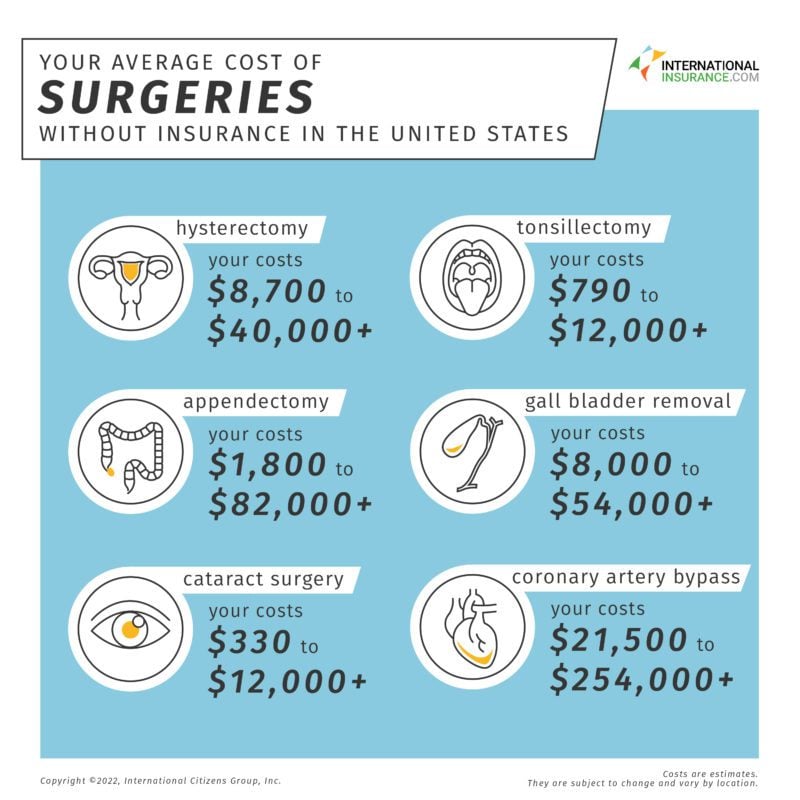
Surgical procedures without a doubt save lives and improve outcomes. With health care costs in the USA, there's a high price to pay for the privilege. That's why we have broken down the ramifications for you. As you can see, the wide range of fees makes the average cost of a hospital stay in the U.S. hard to pin down. Coming in as the most expensive surgical procedure is the coronary artery bypass, which costs, at a minimum, $21,500 up to an astronomical $254,000+ or more.
Appendicitis attacks tend to come on quickly and require urgent attention, and that emergency appendectomy costs anywhere between $1,800 and $82,000+. Gallbladder removal costs between $8,000 to or even above $54,000. A hysterectomy starts at $8,700 but can shoot up to $40,000+. Cataract surgery is between $330 and $12,000+. That's the same as the uppermost cost of a tonsillectomy, where the lowest prices are a more reserved $790.
What Is the Cost of a Broken Bone or Sprain?
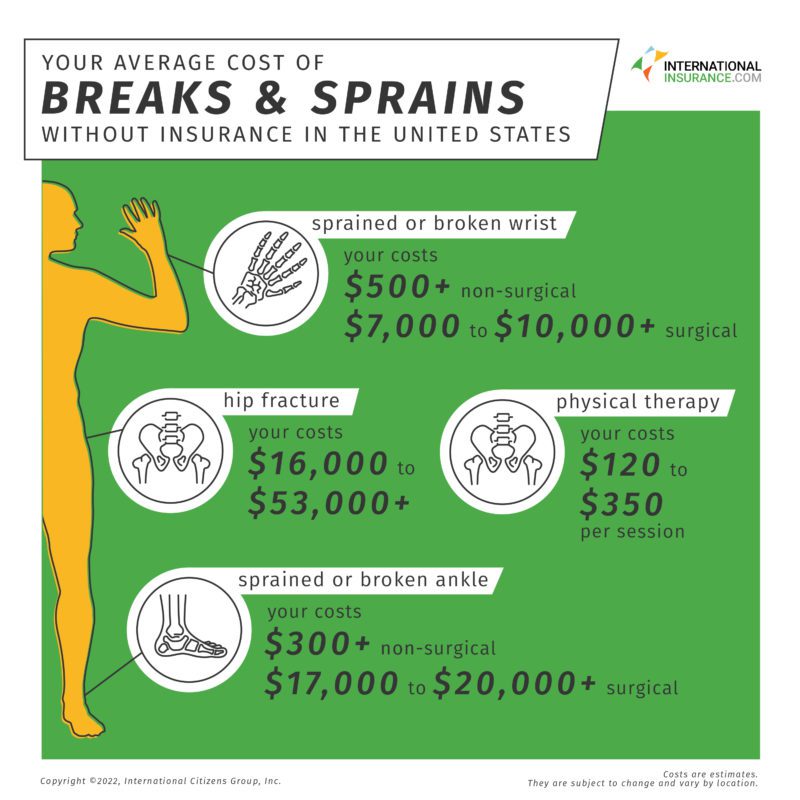
It could be an innocent tumble on the sidewalk, right through to a dramatic sporting injury. Whatever the scenario, breaks and sprains happen all the time and they are expensive for the uninsured.
A hip fracture starts at $16,000 for treatment, and goes up to $53,000+. A sprained or broken ankle could cost $300+ if surgery is not needed. But it soon jumps to a rather more unpalatable $17,000 to $20,000+ if a trip to the operating room is involved. A sprained or broken wrist costs $500+ on a non-surgical basis and leaps to $7,000 to $10,000+ if surgery is required. The resulting physical therapy will also cost you, coming in at $120 to $350 per session.
How Much is a Doctor's Visit in the United States?
A visit to the doctor's office is relatively affordable. However, if you are ill, additional costs will become expensive quickly. An initial consultation with a doctor will cost around $100 - $200. Visits to specialists are typically more expensive depending on their specialty and the nature of your visit. On average, specialists will charge $250 or more for a consultation.
What Is Behind Healthcare Costs in the USA? Why Are Medical Prices So Expensive?

Whether you are a local or a traveler, you cannot deny that the average cost of healthcare in the U.S. is expensive. According to USA Today : “The total costs for a typical family of four insured by the most common health plan offered by employers will average $28,166.” In terms of real dollars and earnings, these prices are keenly felt by the average person.
The cost of deductibles and premiums has grown at a faster rate than income. Deductibles (the amount you pay before your insurance starts to pay for covered services) grew 68.4% from 2011 to 2021, to an average $1,669, according to a report from the Kaiser Family Foundation . In addition, insured people are even more likely to have deductibles in their plans – 85% versus 74% in 2011. On top of that, premiums grew by 47% while worker earnings grew by only 31%. These figures alone prove how expensive healthcare in the USA has become and why even residents have a hard time paying for hospital bills.
The high average cost of healthcare in the U.S. is not the result of one particular challenge but rather a combination of factors that all contribute to increasing the bottom line. As CNBC noted ; “...drugs are more expensive. Doctors get paid more. Hospital services and diagnostic tests cost more. And a lot more money goes to planning, regulating, and managing medical services at the administrative level.” These factors, when put together, create a situation that makes it hard for the ordinary person to pay for medical care, especially when they do not have any health insurance in America to cover their expenses.
The Cost of Medical Care in America With Insurance

If you never go to the doctor, you won't experience these high costs. Some people feel comfortable taking that risk. But for the majority, the risks are too high.
For an expat or visitor in the USA, the best way to offset that risk is to purchase an international health insurance plan. Although a plan requires you to pay a fixed amount even if you never go to the doctor, it will cover your costs for the services detailed in the policy. A high-quality health insurance plan will cover all your costs, minus a deductible , excess, and/or co-pay (the fixed amount you pay for a covered service such as a doctor's office visit - even after you've met your deductible). Plans with higher deductibles and co-pays tend to have lower monthly fees, and vice-versa.
Depending on the plan you choose, all your costs could be covered without limit. But there are certain plans that will put a cap on how much they will pay for your medical expenses. This is called a medical maximum .
Choosing a health insurance plan in the USA with a lower medical maximum will lower your monthly premiums but you will take on additional risks in exchange. If your medical bills exceed the maximum, any additional costs will be your responsibility.
Due to all these factors, the cost of health insurance in America will vary. The cost of an international health insurance plan will be much greater than the cost of a travel medical insurance plan because the former offers more comprehensive coverage. Typically, our clients pay an average of $500 per month for comprehensive global medical health insurance. Compared to paying a $10,000 medical bill out of your own pocket, you can deduce that these premiums are reasonable.
Read: How Much Insurance Do Foreigners Need in the USA ?
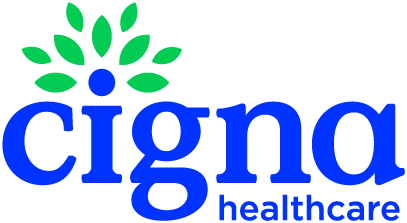
Cigna Global Insurance Plan
- The flexibility to tailor a plan to suit your individual needs
- Access to Cigna Global’s trusted network of hospitals and doctors
- The convenience and confidence of 24/7/365 customer service
Common Costs in the USA Compared To Other Countries
How do the high average cost of healthcare in the U.S. impact the price of common medical procedures and treatments? Let’s look at the cost of an MRI, a frequently used diagnostic tool. All costs listed are from the most recent survey by International Federation of Health Plans , done in 2017. It's important to note that the costs listed below are lower than current U.S. prices; as noted earlier in this article, United States healthcare costs have gone up significantly since 2017.
The average cost of an MRI in the United States, according to the 2017 report, is $1,430. In Holland it's $190 while in New Zealand the price falls in the middle at $750.
The average cost of an angioplasty, which inserts a stent in a blocked blood vessel, was $32,200 in the United States at the time of the report. Meanwhile, in Switzerland, famous for both its high cost of living and its near-perfect health care standards, it's only $7,400.
When you take all of these into account, a common malady among travelers like abdominal pain suddenly becomes very costly. It will require diagnostic imaging and 24 hours of observation, which as discussed above is astronomically expensive. This is just for the diagnosis. Add in treatment and care, and the price goes up further. You can see why the average cost of a hospital stay in the U.S. is so high.
If that abdominal pain is found to be caused by an inflamed appendix that requires immediate surgery , it will cost you an average of $15,200 in the United States, according to the 2017 report. If you are in cost-friendly South Africa, it will be a meager $3,200. On the other hand, things will be a bit more expensive in the UK at $5,100 - that is still over $10,000 less expensive than getting the same treatment in the United States!
On the more dramatic end of the scale, both in terms of pricing and health risks, a bypass operation costs an average of $78,100 in the United States. In The Netherlands, it will cost only $11,700, according to the 2017 report. Either way, the cost of the operation is still far too expensive than what the average person can afford. Getting treated in The Netherlands, however, will be far less likely to cause medical bankruptcy compared to when you undergo the same procedure in the USA.
How Can You Cover Your Medical Costs in the USA?

So what can a frugal traveler or expat do? How do you reduce the cost of receiving proper health care without sacrificing quality or convenience?
Firstly, reassure yourself that common over-the-counter medications and first aid supplies are widely available and very affordable in the United States. Headache medication, mild heartburn medication, muscle cream, sinus decongestant pills, and skin ointments are all available for under $25; sometimes they're as cheap as $5.
A chat with a pharmacist is always free and they can provide sound recommendations for treating non-urgent, minor conditions. A bad cold is no more costly in the United States than it is in most other countries.
Secondly, make sure that you have health insurance in the USA. As you've seen up above, if you are traveling and fall ill, a relatively uncomplicated problem like an inflamed appendix can cost several times more than the trip itself. For non-residents, there is health insurance in the USA for foreigners that can greatly reduce costs of medical services, especially when you need them.
You do not need to face a life-threatening problem and then get slammed with sanity-threatening costs after. There is a wide variety of insurance products and packages designed for travelers. They range from the extremely comprehensive and inclusive to the more streamlined option, with a focus on coverage for the most serious and expensive of emergencies.
There is also health insurance for non-residents that can provide basic coverage for the most common ailments. This could be very helpful since healthcare in the USA is some of the most expensive in the world.
A medical emergency is stressful enough when you are traveling. You do not want it to ruin your life as well as your trip. Get health insurance in the USA to avoid headaches and astronomic costs.
If you're moving or planning to move abroad or going on an international trip and require insurance, then please consider choosing us . Here at International Citizens Insurance, we provide consumers with a resource to research, compare and purchase plans for their relocation abroad or international trip.
Through our website, we can offer some of the very best international health insurance , travel medical insurance , group insurance , and travel insurance policies to people from all around the world.

Xplorer Worldwide Medical Plan
- Premium Benefits, Coverage and Service
- Define your deductible and prescription benefits
- For Foreigners in the US or US citizens abroad
*Disclaimer: the information shown in these infographics is directional to help decision-making. Medical costs and charges are subject to change at any time and vary greatly from one geographic location to another and from one insurance plan to another.
Author: Joe Cronin , Founder and President of International Citizens Insurance . Mr. Cronin, a former expat, is an authority in the areas of international travel, and global health, life, and travel insurance, with expertise in advising individuals and groups on benefits for today's global workforce. Follow him on LinkedIn or Twitter .

Expat Insurance: Health, Life, and Travel Insurance

US Citizens Living Overseas: Insurance For US Expats

Visitors Insurance Coverage

US Health Insurance for Non-Citizens

America: Safety and Travel Insurance for the USA
Get a fast, free, international insurance quote., global medical plans, specialty coverage, company info, customer service.

UnitedHealthcare Individual & Family ACA Marketplace plans
Let's help you find your personalized Individual & Family ACA Marketplace plan. Enter your ZIP code to view and enroll in 2024 plans.
Which county are you in? UnitedHealthcare Individual & Family ACA plans are not available in your area. But we can still help. No results found near you
Your ZIP code and county determine which ACA plans are available.
We couldn’t find UnitedHealthcare Individual & Family ACA plans in your area. But you can call a UnitedHealthcare licensed insurance agent to get help finding an ACA plan that’s available near you — or go to HealthMarkets to see ACA plans from other companies online.
Call 1-877-732-0569
We couldn't find UnitedHealthcare Individual & Family ACA plans in your area. ACA plans from another company may be available through New York State of Health.
Questions? Talk with a licensed insurance agent at: 1-800-557-6718 , TTY 711
See ACA Marketplace plans
Find your personalized aca marketplace plan, aca marketplace plans with benefits that fit your needs.
unlimited primary care
Virtual urgent care 1
or less prescription drugs 2
in rewards for health 3
The affordable Marketplace plan options you've been looking for
We offer a variety of Individual & Family ACA Marketplace plans that are classified into 5 plan categories. Within these categories, “metal” levels tell you how costs are divided between you and UnitedHealthcare.
Essential High-deductible plans with basic coverage for serious illness or injury. Pay a low $0 4 monthly premium, but more when you get care.
What to know.
This is our lowest-cost plan. Your monthly premium could be as low as $0, but you'll pay more when you get care, compared to our other plans. Essential plans are available at the Bronze metal level only.
It's a good fit if
You rarely see your doctor. You want a low-cost way to protect yourself from worst-case medical scenarios, like serious illness or injury.
The UnitedHealthcare Essential Plan

Video transcript
[UnitedHealthcare logo]
ON-SCREEN TEXT: Individual & Family ACA Marketplace health plans
UnitedHealthcare Essential Plan
ON-SCREEN TEXT: Essential Plan
Your budget + Coverage that fits your needs
fits your budget and your health needs. It’s a great choice if you rarely see a doctor or want protection from serious illness or injury.
ON-SCREEN TEXT: Premiums as low as $0 1
Your monthly premium could be as low as zero dollars but you’ll pay more for care compared to our other plans.
ON-SCREEN TEXT: $0 virtual urgent care 2
You’ll get benefits like zero dollar virtual urgent care,
ON-SCREEN TEXT: $5 or less prescription drugs 2
low cost prescription drugs
ON-SCREEN TEXT: $100 in rewards 2
and up to $100 in rewards.
ON-SCREEN TEXT: Prescription delivery at no additional cost 3
Plus, extras like no cost delivery for prescriptions,
ON-SCREEN TEXT: 20% off Walgreens branded products 3
discounts on Walgreens health and wellness products,
ON-SCREEN TEXT: On-demand fitness classes 3
and on-demand fitness classes.
ON-SCREEN TEXT: In-network providers
And remember, UnitedHealthcare plans give you access to a huge selection of in-network providers
ON-SCREEN TEXT: In-network pharmacies
and over 40,000 in-network pharmacies.
ON-SCREEN TEXT: Enroll in an Individual & Family ACA Marketplace plan today
Essential Plan
Get no-cost 1-on-1 help to enroll in a plan today.
DISCLAIMERS:
1 To qualify for a $0 monthly premium, you must meet household income requirements for Advanced Premium Tax Credits.
2 The benefits described may not be offered in all plans or in all states. Some plans may require copayments, deductibles and/or coinsurance for these benefits. This policy has exclusions, limitations, reductions of benefits, and terms under which the policy may be continued in force or discontinued. For costs and complete details of the coverage, review your plan documents, call or write your insurance agent or the company, whichever is applicable. Plan specifics and benefits vary by coverage area and by plan category. Please review plan details to learn more. By responding to this offer, you agree that a representative may contact you.
3 UnitedHealthcare Internal Analysis, June 2023
UnitedHealthcare Individual & Family plans medical plan coverage offered by: UnitedHealthcare of Arizona, Inc.; Rocky Mountain Health Maintenance Organization Incorporated in CO; UnitedHealthcare of Florida, Inc.; UnitedHealthcare of Georgia, Inc; UnitedHealthcare of Illinois, Inc.; UnitedHealthcare Insurance Company in AL, KS, LA, MO, NJ, and TN; Optimum Choice, Inc. in MD and VA; UnitedHealthcare Community Plan, Inc. in MI; UnitedHealthcare of Mississippi, Inc.; UnitedHealthcare of New Mexico, Inc.; UnitedHealthcare of North Carolina, Inc.; UnitedHealthcare of Ohio, Inc.; UnitedHealthcare of Oklahoma, Inc.; UnitedHealthcare of South Carolina, Inc.; UnitedHealthcare of Texas, Inc.; UnitedHealthcare of Oregon, Inc. in WA; and UnitedHealthcare of Wisconsin, Inc. Administrative services provided by United HealthCare Services, Inc. or its affiliates.
Virtual Plans 5 Convenient, low-premium plans with unlimited 24/7 access to $0 5 virtual primary, urgent and specialty care. No copays. No coinsurance. Just quality virtual care through Galileo from your smartphone or tablet.
Built with flexibility and convenience on the go, this plan offers unlimited 24/7 $0 virtual care through the Galileo mobile app. Your 24/7 access to virtual care lets you interact with your doctor on your own schedule, when it’s most convenient for you. The Galileo mobile app will be your first stop for all your care needs, from everyday to urgent - including virtual primary and virtual specialty care. Virtual First and Virtual Access plans are available at the Bronze, Silver and Gold metal levels.
You like the convenience to text or have a video visit with a doctor instead of heading to the clinic.
Looking for a Spanish-speaking option?
This may be the plan for you. It offers the option to get your Galileo communications in Spanish and connect with a Spanish-speaking Galileo doctor right away.
The UnitedHealthcare Virtual First plan

Virtual First Plan
Your digital lifestyle + Benefits at your fingertips
The UnitedHealthcare Virtual First plan fits your digital lifestyle with care at your fingertips.
It’s a great choice if you prefer to talk, text or have a video visit with a doctor instead of going to the clinic.
ON-SCREEN TEXT:
Virtual First health care plans include zero-dollar unlimited virtual care.
ON-SCREEN TEXT: 24/7 access to care with Galileo app
Primary care
Specialty care
Urgent care
Using the Galileo app, you’ll have 24/7 access to primary, specialty and urgent care. Including care from Spanish-speaking doctors.
ON-SCREEN TEXT: $5 or less prescription drugs 1
You’ll also get benefits like prescription drugs for five dollars or less
ON-SCREEN TEXT: Network pharmacies
from thousands of in-network pharmacies
ON-SCREEN TEXT: Prescriptions delivered at no additional cost
and no-cost prescription delivery.
ON-SCREEN TEXT: Earn $100 in rewards 1
20% off Walgreens brand products 1
Digital fitness classes on-demand
Plus, extras like rewards, discounts at Walgreens and on-demand digital fitness classes.
Get no-cost one-on-one help today.
1 The benefits described may not be offered in all plans or in all states. Some plans may require copayments, deductibles and/or coinsurance for these benefits. This policy has exclusions, limitations, reductions of benefits, and terms under which the policy may be continued in force or discontinued. For costs and complete details of the coverage, review your plan documents, call or write your insurance agent or the company, whichever is applicable. Plan specifics and benefits vary by coverage area and by plan category. Please review plan details to learn more. By responding to this offer, you agree that a representative may contact you.
Value Plans with additional benefits, like $0 doctor visits from the first day of coverage as well as a Health Savings Account (HSA) option.
This plan isn’t as low-cost as Essential, but it’s close. It offers low-copay primary care visits with your doctor, and an HSA option. Like our other plans, this plan also has the option for virtual care. Value plans are available at the Bronze, Silver and Gold metal levels.
You regularly see your doctor and want something with a few more benefits than the basic Essential plan, without paying a lot for it.
The UnitedHealthcare Value Plan

Your budget + Coverage that fits
The UnitedHealthcare Value Plan offers a balance of coverage that fits your budget and needs.
It’s a great choice if you see your doctor regularly but don’t want to break your budget.
ON-SCREEN TEXT: Low-cost primary care
Value plans offer primary care at low or no cost.
ON-SCREEN TEXT: $0 unlimited virtual urgent care 1
$5 or less prescription drugs 1
You’ll also get benefits like zero-dollar virtual urgent care and prescription drugs at five dollars or less.
ON-SCREEN TEXT: Health Savings Account
Some Value plans also offer a Health Savings Account option.
With extras like a hundred dollars in rewards, Walgreens discounts, and on-demand digital fitness classes, the Value Plan keeps you covered at a price that fits your budget.
ON-SCREEN TEXT: Network providers
Network pharmacies
And remember, UnitedHealthcare plans give you access to a huge selection of in-network providers and over 40,000 in-network pharmacies.
Advantage Low or $0 deductible plans with extras, like adult vision and dental benefits. 6 Pay slightly higher monthly premium and lower costs when you get care.
This is our richest plan with the most coverage. It could be a good fit if you’re used to having lots of coverage and perks (like embedded adult vision and dental benefits). Advantage plans are available at the Silver and Gold metal levels.
You see your doctor often. You’re typically willing to pay a little more each month in order to pay less (usually copays) when you get care.
The UnitedHealthcare Advantage Plan

Advantage Plan
Your health needs + Coverage and benefits that fit
The UnitedHealthcare Advantage Plan gives you lots of benefits that fit your health needs.
This plan is a great choice if you see your doctor often and want a plan with lots of extras.
ON-SCREEN TEXT: $0 primary care 1
You’ll get lots of benefits like zero-dollar primary care,
ON-SCREEN TEXT: $0 virtual urgent care 1
and zero-dollar virtual urgent care,
prescription drugs at five dollars or less,
and up to one hundred dollars in rewards.
ON-SCREEN TEXT: $0 dental preventive visits 1
You’ll also get zero-dollar dental preventive visits
ON-SCREEN TEXT: $0 routine vision exams 1
and zero dollar routine vision exams.
ON-SCREEN TEXT: Prescription delivery at no additional cost
$0 gym membership 1
With extras like no cost delivery for prescriptions, Walgreens discounts, zero dollar memberships at in-network gyms, and on-demand digital fitness classes, the Advantage Plan helps you feel confident your needs are covered.
Copay Focus 7 $0 medical deductible plans with flat copays for most services. Know what you pay before you see your doctor.
With a $0 deductible, you won't have to worry about paying out-of-pocket costs before your plan kicks in. You'll pay defined copays, like $15 or $30, for most services starting the first day of your plan. Copay Focus plans are available at the Bronze, Silver and Gold metal levels.
You like greater cost transparency. You’re typically willing to pay a little more each month in order to pay lower, defined copays when you get care.
The UnitedHealthcare Copay Focus Plan

ON-SCREEN TEXT: Copay Focus Plan
The UnitedHealthcare Copay Focus Plan gives you predictable costs while fitting your health needs.
It’s a great choice if you want to know how much your care costs before you see a doctor.
ON-SCREEN TEXT: $0 medical deductible 1
With $0 medical deductible, you won’t have to worry about paying out of pocket to reach a deductible before your plan kicks in.
$100 in rewards 1
You’ll get benefits like low-cost virtual care, low-cost prescription drugs and up to a hundred dollars in rewards.
ON-SCREEN TEXT: No-cost prescription delivery 1
Digital fitness classes on-demand 1
With extras like no-cost delivery for prescriptions, discounts on Walgreens health and wellness products, and on-demand digital fitness classes, the Copay Focus plan keeps you covered at a price you can count on.
ON-SCREEN TEXT: Enroll in an Individual & Family ACA Marketplace plan today Copay Focus Plan
Get no-cost one-on-one help to enroll in a plan today.
Simple, easy plan enrollment
Begin the enrollment process in 3 simple steps.
Tell us about you and your family.
See the best plan(s) recommended for you.
Choose a plan and we'll help you enroll.
Learn more about Marketplace health insurance plans and how they work
Read about the healthcare Marketplace to get the most from your Individual & Family ACA Marketplace plan.

ON-SCREEN TEXT: Individual & Family ACA Marketplace health care plans
Your unique needs + Coverage that fits your budget
UnitedHealthcare Individual & Family ACA Marketplace plans offer coverage that fits your unique needs and your budget.
ON-SCREEN TEXT: $0 monthly premiums 1
More than half of our members pay zero dollars in monthly premiums.
ON-SCREEN TEXT: $0 Preventive care 2
Our plans offer benefits like zero-dollar preventive care,
ON-SCREEN TEXT: $0 Virtual urgent care 2
zero-dollar virtual urgent care,
low-cost prescription drugs
20% off Walgreens brand products 2
With extras like no-cost delivery for prescriptions, Walgreens discounts and on-demand digital fitness classes, Individual and Family ACA Marketplace plans have your health needs covered at a price you can afford.
ON-SCREEN TEXT: Enroll by December 15, 2023 for coverage starting January 1, 2024
Open enrollment starts November 1st and lasts until January 15th in most states. For coverage starting January 1st you must enroll by December 15th.
ON-SCREEN TEXT: Answer questions
See plan options
Select your plan
Enrollment is simple. First, we will ask you a few questions, next we will show you your plan options and an estimated cost, and then you choose the plan that fits you best.
1 UnitedHealthcare Internal Analysis Sept 2023. To qualify for a $0 monthly premium, you must meet household income requirements for Advanced Premium Tax Credits.
Find Individual & Family ACA Marketplace plans in your state
If you buy your own health insurance for you or your family, the health care Marketplace is for you. The Marketplace (also called the Exchange) is where ACA health plans are sold. You might also hear these plans called Exchange plans or Individual & Family plans. Don’t worry, they’re all the same thing — affordable health plan options for you and your family.
We offer Individual & Family plans in 26 states, including Texas, Florida and Georgia. Plan details vary by state, like premiums, network and certain benefits. The good news? We've got some great universal benefits that everyone can get — no matter where you live.
Want to know more about ACA Marketplace plans?
Let's cover a few more basics about ACA Marketplace plans.
What exactly are ACA Marketplace health insurance plans?
ACA Marketplace plans are health care plans that people can buy on their own, rather than through an employer or another government-run program, like Medicare or Medicaid. You might also hear these plans called Exchange plans or Individual & Family plans. The health care Marketplace (also called the Exchange) is where ACA health care plans are sold.
How can I save money on the health care Marketplace?
Under the American Rescue Plan Act of 2021 (ARPA) and Inflation Reduction Act of 2022 , you may qualify for financial subsidies that will lower your premiums when you enroll in ACA Marketplace coverage. These subsidies could be tax credits or cost-sharing reductions to help pay for your health care costs.
When can I enroll?
2024 Open Enrollment starts Nov. 1, 2023, and ends Jan. 15, 2024, in most states.
Need to find health care coverage outside that enrollment window? You might qualify for a Special Enrollment Period (SEP). Learn about SEP .

Looking for a plan?
Enter your ZIP code to see plans in your area.
Talk with a licensed insurance agent at: 1-800-557-6718 , TTY 711
8 a.m. – 8 p.m. ET, Monday – Friday 9 a.m. – 5:30 p.m. ET, Saturday Closed: Sunday
Already a member?
Call our Member Services team at: 1-877-265-9199 , TTY 711
24/7 Member Services + Care Support or sign in to our member site.
Sign up for updates
Get helpful tips and information to help you better understand your options. 8
The independent source for health policy research, polling, and news.
Americans’ Challenges with Health Care Costs
Lunna Lopes , Alex Montero , Marley Presiado , and Liz Hamel Published: Mar 01, 2024
This issue brief was updated on March 1, 2024 to include the latest KFF polling data.
For many years, KFF polling has found that the high cost of health care is a burden on U.S. families, and that health care costs factor into decisions about insurance coverage and care seeking. These costs and the prospect of unexpected medical bills also rank as the top financial worries for adults and their families, and recent polling shows that lowering out-of-pocket health care costs is by and large the public’s top health care priority. Health care affordability is also one of the top issues that voters want to hear presidential candidates talk about during the 2024 election. This data note summarizes recent KFF polling on the public’s experiences with health care costs. Main takeaways include:
- About half of U.S. adults say it is difficult to afford health care costs, and one in four say they or a family member in their household had problems paying for health care in the past 12 months. Younger adults, those with lower incomes, adults in fair or poor health, and the uninsured are particularly likely to report problems affording health care in the past year.
- The cost of health care can lead some to put off needed care. One in four adults say that in the past 12 months they have skipped or postponed getting health care they needed because of the cost. Notably six in ten uninsured adults (61%) say they went without needed care because of the cost.
- The cost of prescription drugs prevents some people from filling prescriptions. About one in five adults (21%) say they have not filled a prescription because of the cost while a similar share say they have instead opted for over-the-counter alternatives. About one in ten adults say they have cut pills in half or skipped doses of medicine in the last year because of the cost.
- Those who are covered by health insurance are not immune to the burden of health care costs. About half (48%) of insured adults worry about affording their monthly health insurance premium and large shares of adults with employer-sponsored insurance (ESI) and those with Marketplace coverage rate their insurance as “fair” or “poor” when it comes to their monthly premium and to out-of-pocket costs to see a doctor.
- Health care debt is a burden for a large share of Americans. About four in ten adults (41%) report having debt due to medical or dental bills including debts owed to credit cards, collections agencies, family and friends, banks, and other lenders to pay for their health care costs, with disproportionate shares of Black and Hispanic adults, women, parents, those with low incomes, and uninsured adults saying they have health care debt.
- Notable shares of adults still say they are worried about affording medical costs such as unexpected bills, the cost of health care services (including out-of-pocket costs not covered by insurance, such as co-pays and deductibles), prescription drug costs, and long-term care services for themselves or a family member. About three in four adults say they are either “very” or “somewhat worried” about being able to afford unexpected medical bills (74%) or the cost of health care services (73%) for themselves and their families. Additionally, about half of adults would be unable to pay an unexpected medical bill of $500 in full without going into debt.
Difficulty Affording Medical Costs
Many U.S. adults have trouble affording health care costs. While lower income and uninsured adults are the most likely to report this, those with health insurance and those with higher incomes are not immune to the high cost of medical care. About half of U.S. adults say that it is very or somewhat difficult for them to afford their health care costs (47%). Among those under age 65, uninsured adults are much more likely to say affording health care costs is difficult (85%) compared to those with health insurance coverage (47%). Additionally, at least six in ten Black adults (60%) and Hispanic adults (65%) report difficulty affording health care costs compared to about four in ten White adults (39%). Adults in households with annual incomes under $40,000 are more than three times as likely as adults in households with incomes over $90,000 to say it is difficult to afford their health care costs (69% v. 21%). (Source: KFF Health Care Debt Survey: Feb.-Mar. 2022 )
When asked specifically about problems paying for health care in the past year, one in four adults say they or a family member in their household had problems paying for care, including three in ten adults under age 50 and those with lower household incomes (under $40,000). Affording health care is particularly a problem for those who may need it the most as one-third of adults who describe their physical health as “fair” or “poor” say they or a family member had problems paying for health care in the past 12 months. Among uninsured adults, half (49%) say they or a family member in their household had problems paying for health care, including 51% of uninsured adults who say they are in fair or poor health.
The cost of care can also lead some adults to skip or delay seeking services. One-quarter of adults say that in the past 12 months, they have skipped or postponed getting health care they needed because of the cost. The cost of care can also have disproportionate impacts among different groups of people; for instance, women are more likely than men to say they have skipped or postponed getting health care they needed because of the cost (28% vs. 21%). Adults ages 65 and older, most of whom are eligible for health care coverage through Medicare, are much less likely than younger age groups to say they have not gotten health care they needed because of cost.
One in four immigrant adults (22%) say they have skipped or postponed care in the past year, rising to about a third (36%) among those who are uninsured. Seven in ten (69%) of immigrant adults who skipped or postponed care (15% of all immigrant adults) said they did so due to cost or lack of health coverage. (Source: The 2023 KFF/LA Times Survey of Immigrants: Apr.-June 2023 )
Six in ten uninsured adults (61%) say they have skipped or postponed getting health care they needed due to cost. Health insurance, however, does not offer ironclad protection as one in five adults with insurance (21%) still report not getting health care they needed due to cost.
KFF health polling from March 2022 also looked at the specific types of care adults are most likely to report putting off and found that dental services are the most common type of medical care that people report delaying or skipping, with 35% of adults saying they have put it off in the past year due to cost. This is followed by vision services (25%), visits to a doctor’s offices (24%), mental health care (18%), hospital services (14%), and hearing services, including hearing aids (10%). (Source: KFF Health Tracking Poll: March 2022 )
A 2022 KFF report found that people who already have debt due to medical or dental care are disproportionately likely to put off or skip medical care. Half (51%) of adults currently experiencing debt due to medical or dental bills say in the past year, cost has been a probititor to getting the medical test or treatment that was recommended by a doctor. (Source: KFF Health Care Debt Survey: Feb.-Mar. 2022 )
Prescription Drug Costs
For many U.S. adults, prescription drugs are a component of their routine care. More than one in four (28%) adults say it is either “somewhat” or “very difficult” for them to afford to pay for prescription drugs. Affording prescription drugs is particularly difficult for adults who take four or more prescription medications (37%) and those in households with annual incomes under $40,000 (40%). Black and Hispanic adults are also more likely than White adults to say it is difficult for them to afford to pay for prescription drugs. (Source: KFF Health Tracking Poll: July 2023 )
The high cost of prescription drugs also leads some people to cut back on their medications in various ways. About one in five adults (21%) say in the past 12 months they have not filled a prescription because of the cost. A similar share (21%) say they have taken an over-the-counter drug instead of getting a prescription filled – rising to about one third of Hispanic adults (32%) and more than one in four adults (27%) with annual household incomes under $40,000. About one in ten adults say that in the past 12 months they have cut pills in half or skipped doses of medicine due to cost. (Source: KFF Health Tracking Poll: July 2023 )
Health Insurance Cost Ratings
Overall, most insured adults rate their health insurance as “excellent” or “good” when it comes to the amount they have to pay out-of-pocket for their prescriptions (61%), the amount they have to pay out-of-pocket to see a doctor (53%), and the amount they pay monthly for insurance (54%). However, at least three in ten rate their insurance as “fair” or “poor” on each of these metrics, and affordability ratings vary depending on the type of coverage people have.
Adults who have private insurance through employer-sponsored insurance or Marketplace coverage are more likely than those with Medicare or Medicaid to rate their insurance negatively when it comes to their monthly premium, the amount they have to pay out of pocket to see a doctor, and their prescription co-pays. About one in four adults with Medicare give negative ratings to the amount they have to pay each month for insurance and to their out-of-pocket prescription costs, while about one in five give their insurance a negative rating when it comes to their out-of-pocket costs to see a doctor.
Medicaid enrollees are less likely than those with other coverage types to give their insurance negative ratings on these affordability measures (Medicaid does not charge monthly premiums in most states, and copays for covered services, where applied, are required to be nominal.) (Source: KFF Survey of Consumer Experiences with Health Insurance )
Health Care Debt
In June 2022, KFF released an analysis of the KFF Health Care Debt Survey , a companion report to the investigative journalism project on health care debt conducted by KFF Health News and NPR, Diagnosis Debt . This project found that health care debt is a wide-reaching problem in the United States and that 41% of U.S. adults currently have some type of debt due to medical or dental bills from their own or someone else’s care, including about a quarter of adults (24%) who say they have medical or dental bills that are past due or that they are unable to pay, and one in five (21%) who have bills they are paying off over time directly to a provider. One in six (17%) report debt owed to a bank, collection agency, or other lender from loans taken out to pay for medical or dental bills, while similar shares say they have health care debt from bills they put on a credit card and are paying off over time (17%). One in ten report debt owed to a family member or friend from money they borrowed to pay off medical or dental bills.
While four in ten U.S. adults have some type of health care debt, disproportionate shares of lower income adults, the uninsured, Black and Hispanic adults, women, and parents report current debt due to medical or dental bills.
Vulnerabilities and Worries About Health Care and Long-Term Care Costs
A February 2024 KFF Health Tracking Poll shows unexpected medical bills and the cost of health care services are at the top of the list of people’s financial worries, with about three-quarters of the public – and similar shares of insured adults younger than 65 – saying they are at least somewhat worried about affording unexpected medical bills (74%) or the cost of health care services (73%) for themselves and their families. Just over half (55%) of the public say they are “very” or “somewhat worried” about being able to afford their prescription drug costs, while about half (48%) of insured adults say they are worried about affording their monthly health insurance premium.
Worries about health care costs pervade among a majority of adults regardless of their financial situation . Among adults who report difficulty affording their monthly bills, more than eight in ten say they are worried about the cost of health care services (86%) or unexpected medical bills (83%). Among those who report being just able to afford their bills, about eight in ten say they are worried about being able to afford unexpected medical bills (84%) or health care services (83%). And even among adults who say they can afford their bills with money left over, six in ten nonetheless say they are “very” or “somewhat worried” about being able to afford unexpected medical bills (62%) or the cost of health care services (60%) for themselves and their family. (Source: KFF Health Tracking Poll: February 2024 )
Many U.S. adults may be one unexpected medical bill from falling into debt. About half of U.S. adults say they would not be able to pay an unexpected medical bill that came to $500 out of pocket. This includes one in five (19%) who would not be able to pay it at all, 5% who would borrow the money from a bank, payday lender, friends or family to cover the cost, and one in five (21%) who would incur credit card debt in order to pay the bill. Women, those with lower household incomes, Black and Hispanic adults are more likely than their counterparts to say they would be unable to afford this type of bill. (Source: KFF Health Care Debt Survey: Feb.-Mar. 2022 )
Among older adults, the costs of long-term care and support services are also a concern. Almost six in ten (57%) adults 65 and older say they are at least “somewhat anxious” about affording the cost of a nursing home or assisted living facility if they needed it, and half say they feel anxious about being able to afford support services such as paid nurses or aides. These concerns also loom large among those between the ages of 50 and 64, with more than seven in ten saying they feel anxious about affording residential care (73%) and care from paid nurses or aides (72%) if they were to need these services. See The Affordability of Long-Term Care and Support Services: Findings from a KFF Survey for a deeper dive into concerns about the affordability of nursing homes and support services.
- Health Costs
- Racial Equity and Health Policy
- Private Insurance
- Affordability
- High Deductible Plans
- Tracking Poll
- Survey on Racism, Discrimination and Health
Also of Interest
- Survey on Racism, Discrimination and Health Project
- Health Care Debt In The U.S.: The Broad Consequences Of Medical And Dental Bills
- KFF Health Tracking Poll – March 2022: Economic Concerns and Health Policy, The ACA, and Views of Long-term Care Facilities
- KFF’s Kaiser Health News and NPR Launch Diagnosis: Debt, a Yearlong Reporting Partnership Exploring the Scale, Impact, and Causes of the Health Care Debt Crisis in America
- How Financially Vulnerable are People with Medical Debt?
Doctor of Education Leadership

Additional Information
- Download the Doctoral Viewbook
- Admissions & Aid
America needs transformative leaders in preK–12 education whose passion for education quality and equity is matched by a knowledge of learning and development, the organizational management skills to translate visionary ideas into practical success, and a firm grasp of the role of context and politics in shaping leadership. Graduates of the three-year, multidisciplinary Doctor of Education Leadership (Ed.L.D.) Program at the Harvard Graduate School of Education will be prepared to become those leaders.
The Ed.L.D Program — taught by faculty from the Harvard Graduate School of Education, the Harvard Business School, and the Harvard Kennedy School — will train you for system-level leadership positions in school systems, state and federal departments of education, and national nonprofit organizations. Ed.L.D. is a full-time, three-year program built on a cohort learning model. Cohorts consist of up to 25 students from diverse professional backgrounds (including district/charter management leaders, nonprofit directors, principals, teachers, and policy researchers) who progress through the program together.
All Ed.L.D. students receive a full tuition funding package plus stipends, work opportunities, and a paid third-year residency at a partner organization.
The Ed.L.D. Program prepares graduates to do work for the public good in the American public education sector, whether that be at the system or state level. Specifically, the program is designed to accelerate the progress graduates make toward achieving meaningful impact in influential roles and/or crossing boundaries in the following spaces in the public education sector:
- PreK–12 district or CMO leadership roles : superintendent of schools, chief academic officer, and/or deputy superintendent
- Foundation/philanthropy roles: director, president and CEO, senior fellow
- Education nonprofit roles : president or executive director of backbone or collective impact organizations which support preK–12 schools. Ed.L.D. graduates will lead education nonprofits that explicitly focus on improving outcomes and opportunities for children, families, and communities.
- State or federal education leadership roles : commissioner or deputy commissioner roles. Could also include public education advocacy or education policy advisers to senior government officials.
- Social Entrepreneurship and Innovation roles: Founder, CEO, president
Curriculum Information
The Ed.L.D. curriculum is a balance of multidisciplinary coursework and practice-based learning. Core courses and electives are taught by recognized leaders from across Harvard’s graduate programs in fields like data-based education reform, organizational change and innovation, and effective leadership strategies for urban schools. You will develop and test your leadership skills through team projects and an immersive third-year residency.
All students in the cohort take the same classes in four foundational content areas: learning and teaching, leadership and organizational change, politics and policy, adult development, and leadership inside and out (including one-on-one executive coaching). Courses taken during the first-year focus on practice-based learning and serve as the framework of your first-year experience.
Sample HGSE Courses
- Leading Change
- How People Learn
- Ed.L.D. Proseminar
- Leadership, Entrepreneurship, and Learning
- Race, Equity, and Leadership
- Practicing Leadership Inside and Out
- Sector Change
- The Workplace Lab for System-Level Leaders
View all courses in the Academic Catalog.
Each cohort member works with program advisers to choose an individualized sequence of electives from any of the Harvard graduate schools. You will work closely with the program faculty and staff during your second year to determine the best match with a partner organization for your third-year residency. Matches are driven by mutual interest between the resident and the partner organization, and each student's career and learning goals and geographic preferences.
- Second Year Practicing Leadership Inside and Out
- Driving Change
- Education Sector Nonprofits
- Negotiation Workshop
- Coaching with Equity in Mind
- Ethnic Studies and Education
- Deeper Learning for All: Designing a 21st Century School System
- Institutional Change in School Organizations, Systems, and Sectors
You will take part in a 10-month paid residency at one of our partner organizations. There, you will work on a strategic project which synthesizes your experience and learning into a written Capstone project. You will stay connected to your Ed.L.D. cohort and HGSE through technology and by returning to Harvard periodically for intensive workshops.
Paid Residency
Our partner organizations include school systems and departments of education, as well as some of the nation's most influential and dynamic nonprofit, mission-based for-profit, and philanthropic organizations.
You will be intentionally pushed out of your comfort zones and asked to work systemically and make a significant contribution to the partner organization. In addition, the residency will provide you with the professional mentoring, practical experiences, and network of connections they need to position themselves as future leaders in the education sector.
Strategic Project
You will define (with supervisors from your partner organization) a strategic project on which to focus. You will have the opportunity to lead one or two major efforts on behalf of the organization, such as the creation or implementation of current initiatives. The project allows you to practice and improve leadership skills, add important value to the mission and strategy of the partner organization, work systemically, and hold high-level accountability.
During the residency period, you will produce a written Capstone. The Capstone is a descriptive, analytic, and reflective account of your third-year leadership contributions to a strategic project within an Ed.L.D. partner organization. It is a demonstration of your ability to engage others, develop strategy to successfully address and diagnose challenges, work toward a vision and goals, and learn from the results.
Sample Topics
- Accountability, Coherence, and Improvement: Leadership Reflection and Growth in the Los Angeles Unified School District
- Leadership Development for Entrepreneurial Education Leaders Working to Build Public & Private Sector Support
- Disrupting Teacher Preparation: Lessons in Collaboration and Innovation Across the Learning to Teach Community of Practice
- Pursuing Educational Equality for English Language Learners
Sample Summaries
- Breaking Down Silos in a School District: Findings from an Ed.L.D. Project in Montgomery County
- Expanding Students' Access to Meaningful STEM Learning Opportunities Through Strategic Community Partnerships
- Developing a New Teacher Leadership and Compensation System in Iowa: A Consensus-Based Process
- Finding Great Teachers for Blended-Learning Schools
GSE Theses and Dissertations from Digital Access to Scholarship at Harvard (DASH)
Program Faculty
Ed.L.D. students learn with renowned faculty from the Harvard Graduate School of Education, Harvard Business School, and Harvard Kennedy School. Faculty from the three schools share their individual expertise in the Ed.L.D. Program and work collaboratively to provide a challenging and coherent experience for students. Faculty who teach in the Ed.L.D. core curriculum and advise Ed.L.D. students include:
Faculty Director

Frank D. Barnes
Frank Barnes is faculty director of the Doctor of Education Leadership Program. He has over 30 years experience as an educator, researcher, and organizer. As a chief accountability officer, he led turnaround efforts for large public school districts, including Boston Public Schools and Charlotte-Mecklenburg Schools.
Kathryn Parker Boudett

Ebony N. Bridwell-Mitchell

Jennifer Perry Cheatham

Elizabeth City

Candice Crawford-Zakian

Marshall Ganz

Adria D. Goodson
Deborah helsing.

Monica C. Higgins

Deborah Jewell-Sherman

Lisa Laskow Lahey

Mary Grassa O'Neill

Irvin Leon Scott

Catherine Snow

Michael L. Tushman
Martin west.

Introduce Yourself
Tell us about yourself so that we can tailor our communication to best fit your interests and provide you with relevant information about our programs, events, and other opportunities to connect with us.
Program Highlights
Explore examples of the Doctor of Education Leadership experience and the impact its community is making on the field:

Do We Need Happiness Teachers?
After a trip to meet with the Dalai Lama, an Ed.L.D. student says we do

Combatting Chronic Absenteeism with Family Engagement
As post-COVID absenteeism rates continue unabated, a look at how strong family-school engagement can help

IMAGES
VIDEO
COMMENTS
Doctors check height, weight, sleep patterns, diet, and the vaccines required by public schools. The range for a yearly physical can be anywhere from $100 to $250 or more without insurance. A CVS Minutecare Clinic may charge just $59 for a sports physical, but not all organizations will accept this as proof of physical health.
Understanding the cost of your doctor visit. In the fourth installment of this 4-part series on health care costs, we look at the different types of care to help you better understand what you'll need to pay. Understanding your health plan costs can help you choose the right coverage and budget for your health care spending.
Level 1 is a minor problem requiring counseling and treatment, spending approximately 10 minutes with a doctor. The average cost of an office visit for a level 5 patient is $234. ... According to Debt.org, the average urgent care visit costs between $100 and $150 with insurance and up to $400 or $500 without insurance.
The cost of a doctor's visit depends on the type of insurance you have. If you do not have insurance, the cost of a doctor's visit is typically between $300 and $600, but prices can vary depending on several factors such as lab tests, where you seek care, and procedures done at the visit. If you do not have insurance or have a high-deductible ...
The cost of a doctor visit is hard to quantify because there are many factors that go into what the final bill is. The average cost of a doctor visit, not including procedures or tests, range from $80-$170 across the U.S. Factors that determine the cost include: The purpose of the visit. What tests or procedures are involved.
Key Points. According to the Agency for Healthcare Research and Quality, the average cost of a visit to the doctor's office in 2016 was $265, with expenses ranging from $159 to $419 depending on the specialty. At an urgent care center you can expect to pay between $100-200 to see a provider, plus the cost of any treatments or testing you may ...
For example, the average visit to a primary care provider costs $186, whereas a visit to a specialist costs $335. Some doctor's offices and urgent care facilities post their visit fee prices and other various treatment costs on their website. However, most do not.
The prices do not include the anesthesia, imaging, and other doctor visit fees that normally accompany doctor visit. StateName. Average Cash Price. Alabama. $83 - $127. Alaska. $112 - $172. Arizona. $94 - $144.
4. Ask about a cash discount. When you're shopping around, always ask for a cash discount. "Many providers will provide a discount if you pay for the entire service at the time of care," Kampine ...
Cost of doctor visit without insurance. A doctor's visit without insurance costs $100 to $600 on average for the office visit fee alone, depending on the location, physician type, and whether it's an initial or follow-up visit. Diagnostic tests, medical treatments, and other services often increase the cost. Many doctors now offer virtual ...
New legislation requires doctors to submit prescription information to a centralized database to prohibit abuse. Georgia. - Most common family practice visit costs. --- Medicare recipients: $98.79 for established patients ($85.46 for new patients) --- Other insurance holders: $24.70 for established patients ($21.36 for new patients)
A 2017 Health Affairs study. shows the average cost of a telehealth visit for an acute respiratory infection (such as a sinus infection, laryngitis, or bronchitis) was $79 compared to $146 for an in-person visit.That's almost a 50% savings. When you consider the time and gas you save driving to a doctor's office, the cost of telehealth may ...
Estimating Your Costs. Our convenient treatment fee tool and Sample Fee List help you manage your health expenses by providing a general estimate of your out-of-pocket costs for many of the most common medical exams, tests, and procedures. This can help you prepare for your next appointment or plan for your yearly health care expenses. To get ...
Your total costs for the year include your plan's: Monthly premium x 12 months: The amount you pay to your insurance company each month to have health insurance. Copayments and coinsurance: Payments you make to your health care provider each time you get care, like $20 for a doctor visit or 30% of hospital charges.
The most common physician visits are coded as Level 3, which average $90 per visit. Overall, the average cost of an outpatient visit was $105 in 2018. The following chart shows how the cost of an office visit has changed over time for each level. Costs have increased over the past 10 years for all levels of outpatient visits
Doctor On Demand is a covered benefit for over 98 million Americans, which means your visit will cost $0. If not a covered benefit, prices start at $89. See a doctor with or without insurance! We partner with leading health plans and employers to serve millions of members around the country.
But if you have a higher than average personal income (over $97,000) or household income (over $194,000), you will have to pay a higher monthly premium for Medicare Part B. The monthly adjustment ...
The cost of paying for health care services, including urgent care, typically increases significantly if you don't have health insurance. For example, if you cut your finger and need a few ...
However, if you are ill, additional costs will become expensive quickly. An initial consultation with a doctor will cost around $100 - $200. Visits to specialists are typically more expensive depending on their specialty and the nature of your visit. On average, specialists will charge $250 or more for a consultation.
Let's say the Medicare-approved costs were $100 for the doctor visit and $900 for the MRI. Assuming that you've paid your Part B deductible, and that Part B covered 80% of these services, you'd still be left with some costs. In this scenario, you'd typically pay $20 for the doctor visit and $180 for the x-rays.
The health care Marketplace is where ACA plans are sold. These are plans that people can buy on their own, rather than through an employer or government program.
Medicare Part B typically covers 80% of doctor visits after you have met your deductible. Copayment costs can quickly add up, however, if follow-up appointments are needed.
This issue brief was updated on March 1, 2024 to include the latest KFF polling data. For many years, KFF polling has found that the high cost of health care is a burden on U.S. families, and that ...
The Ed.L.D. curriculum is a balance of multidisciplinary coursework and practice-based learning. Core courses and electives are taught by recognized leaders from across Harvard's graduate programs in fields like data-based education reform, organizational change and innovation, and effective leadership strategies for urban schools.
If you have questions about who pays first, or if your coverage changes, call the Benefits Coordination & Recovery Center at 1-855-798-2627 (TTY: 1-855-797-2627). Tell your doctor and other health care provider about any changes in your insurance or coverage when you get care. Learn how Medicare drug coverage may impact other program benefits.
Use our Form Filler tool to fill out your child's form on a desktop or laptop computer and then print it.If you are experiencing technical issues with the Form Filler, download a PDF. Tips to complete your child's form:. Do not sign your child's form until asked to do so by a passport acceptance agent or employee.; You can apply for a passport book, a passport card, or both documents.